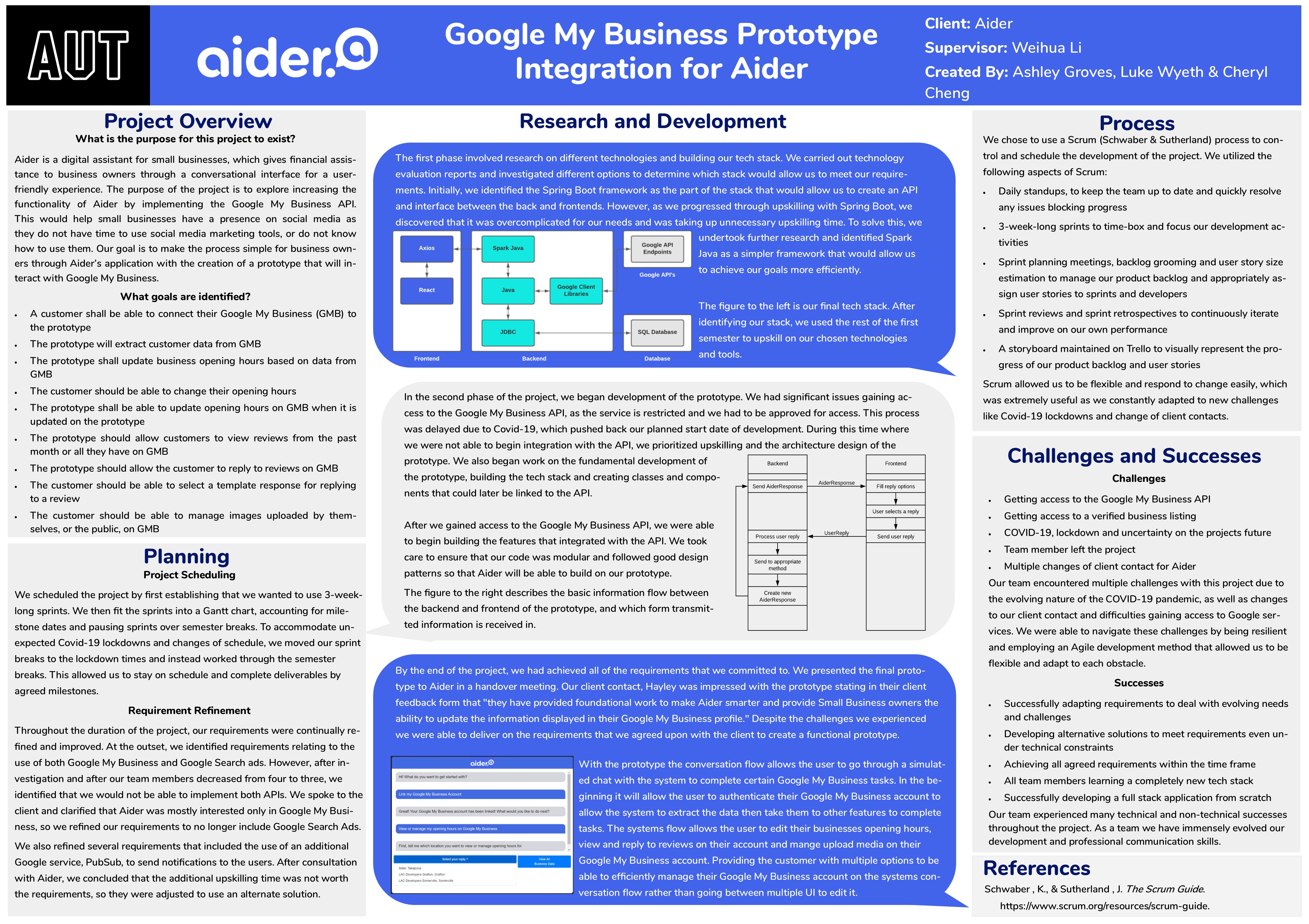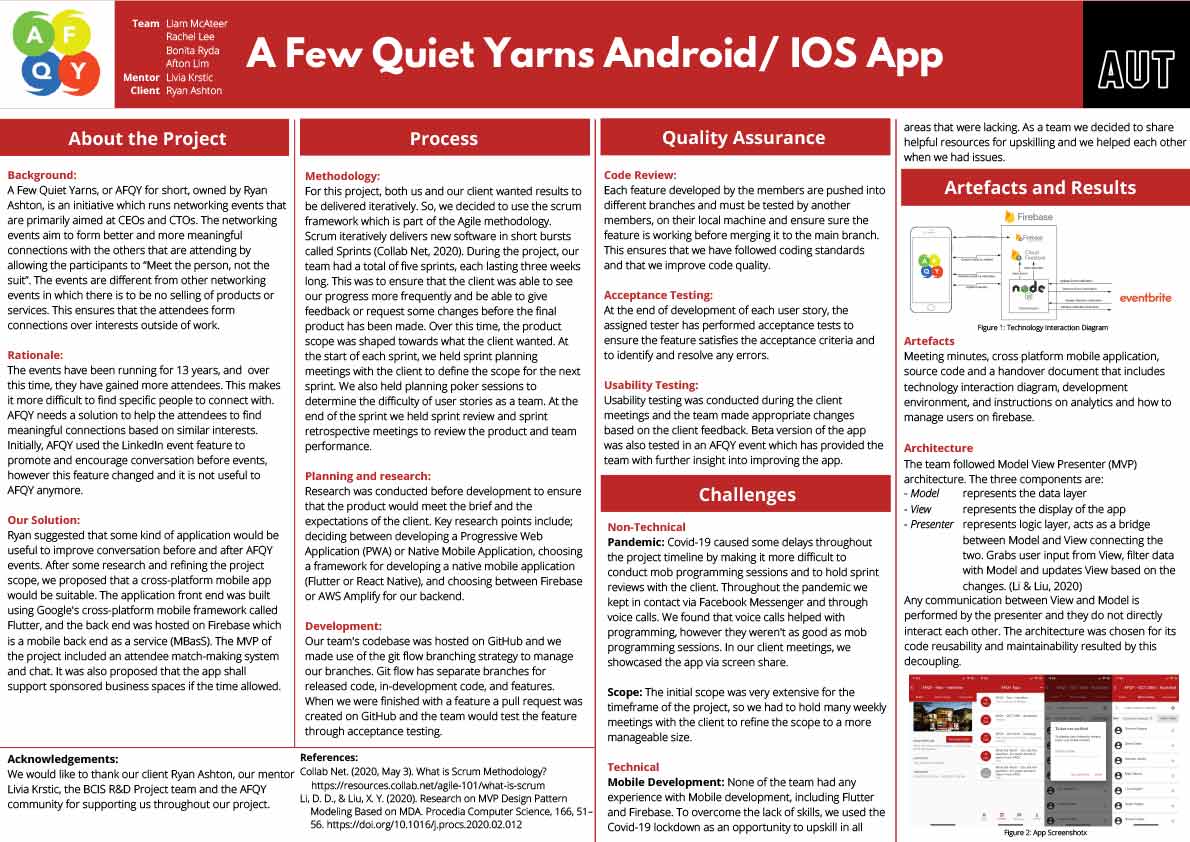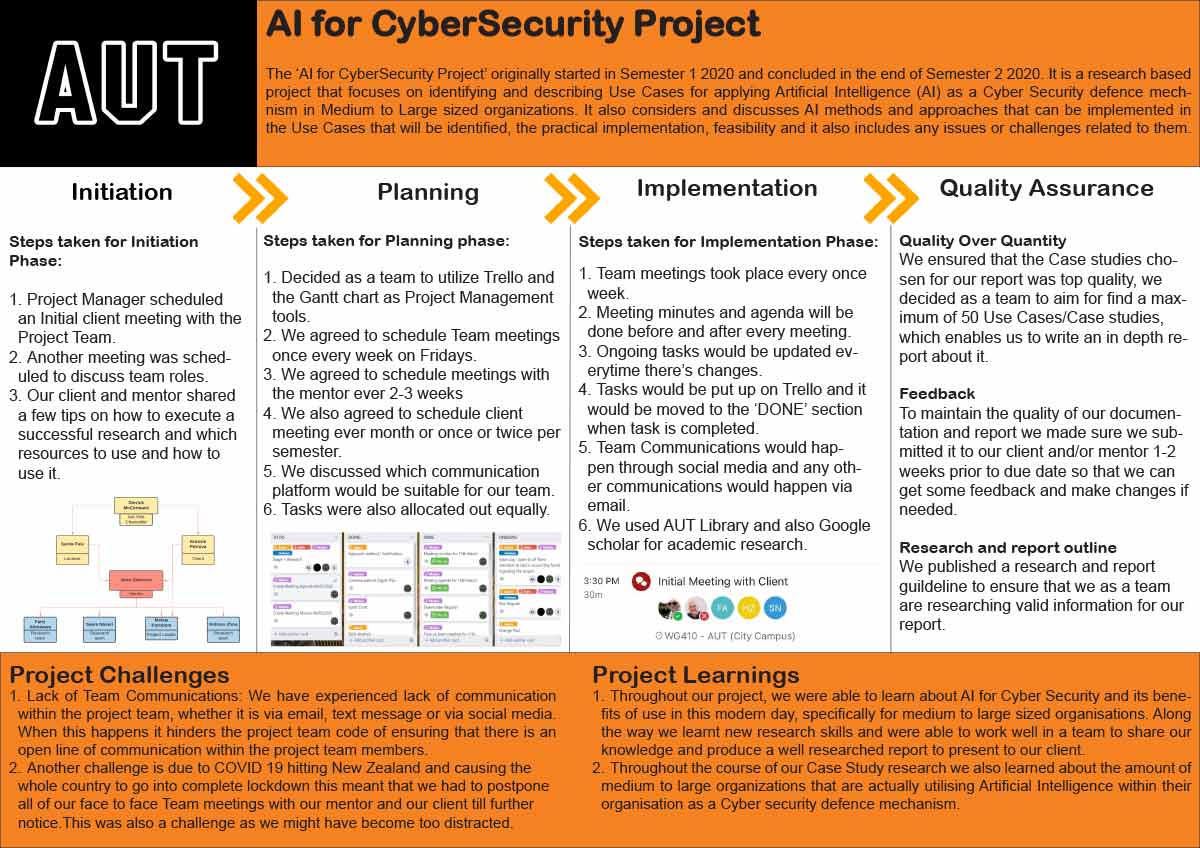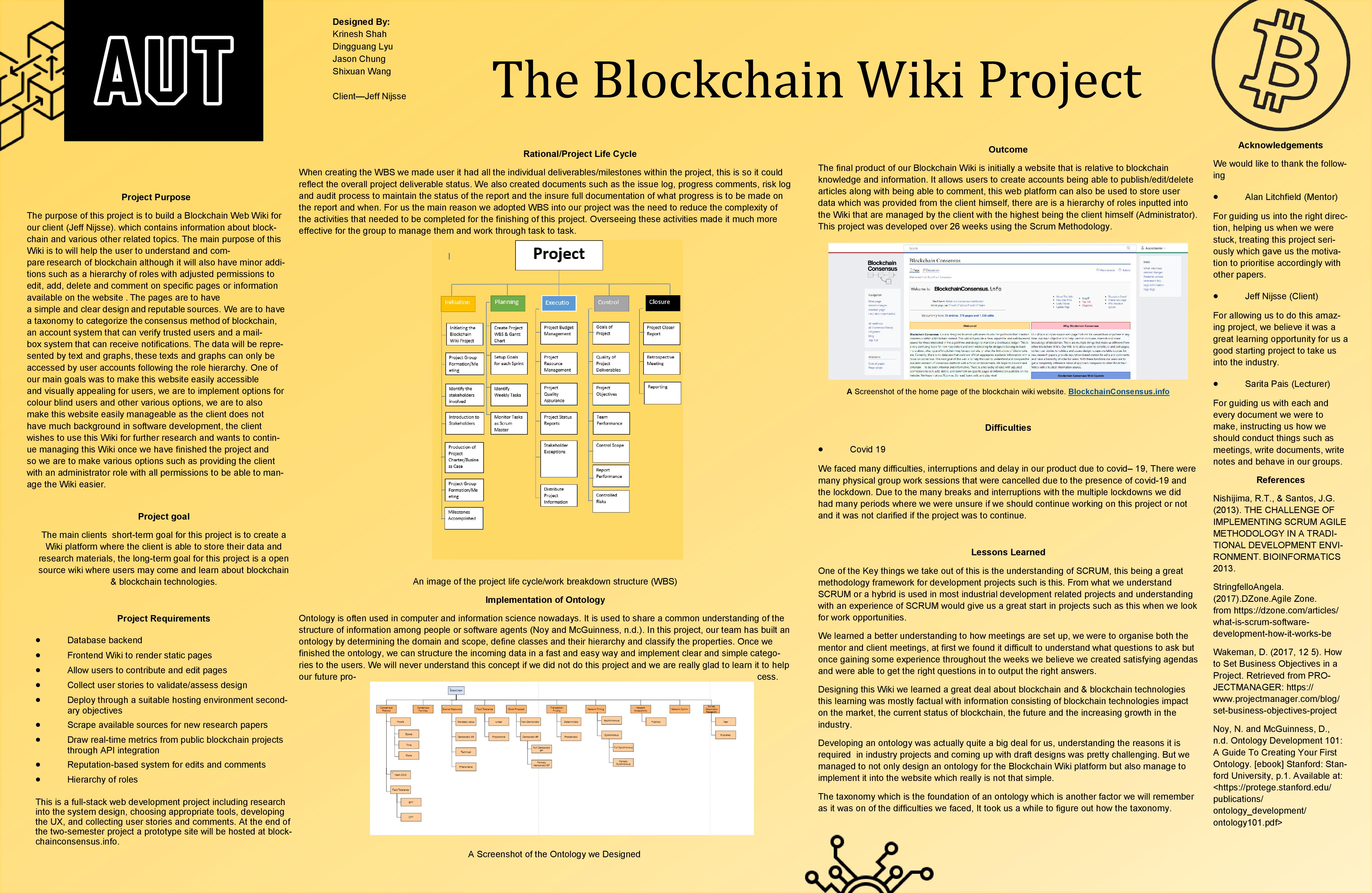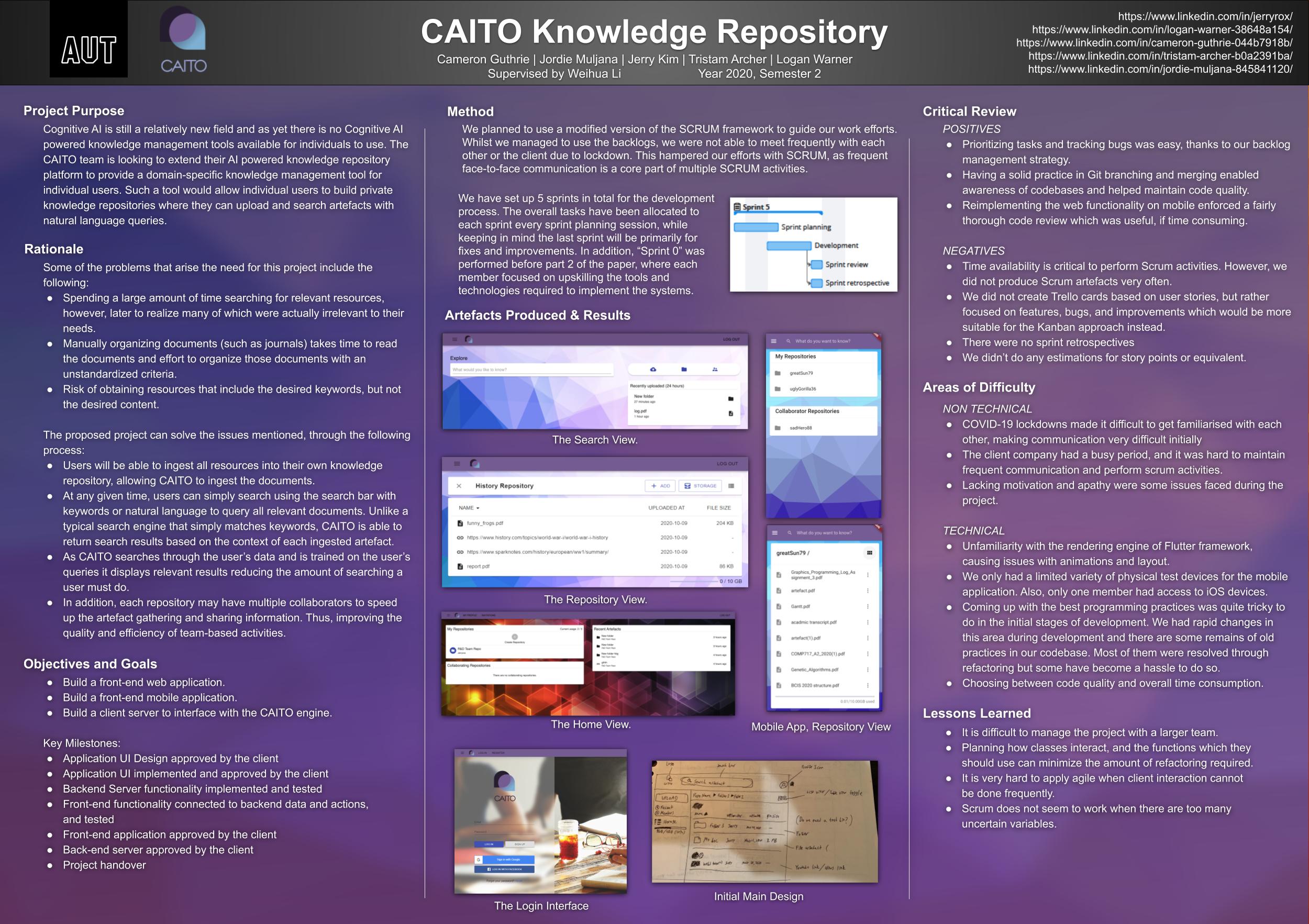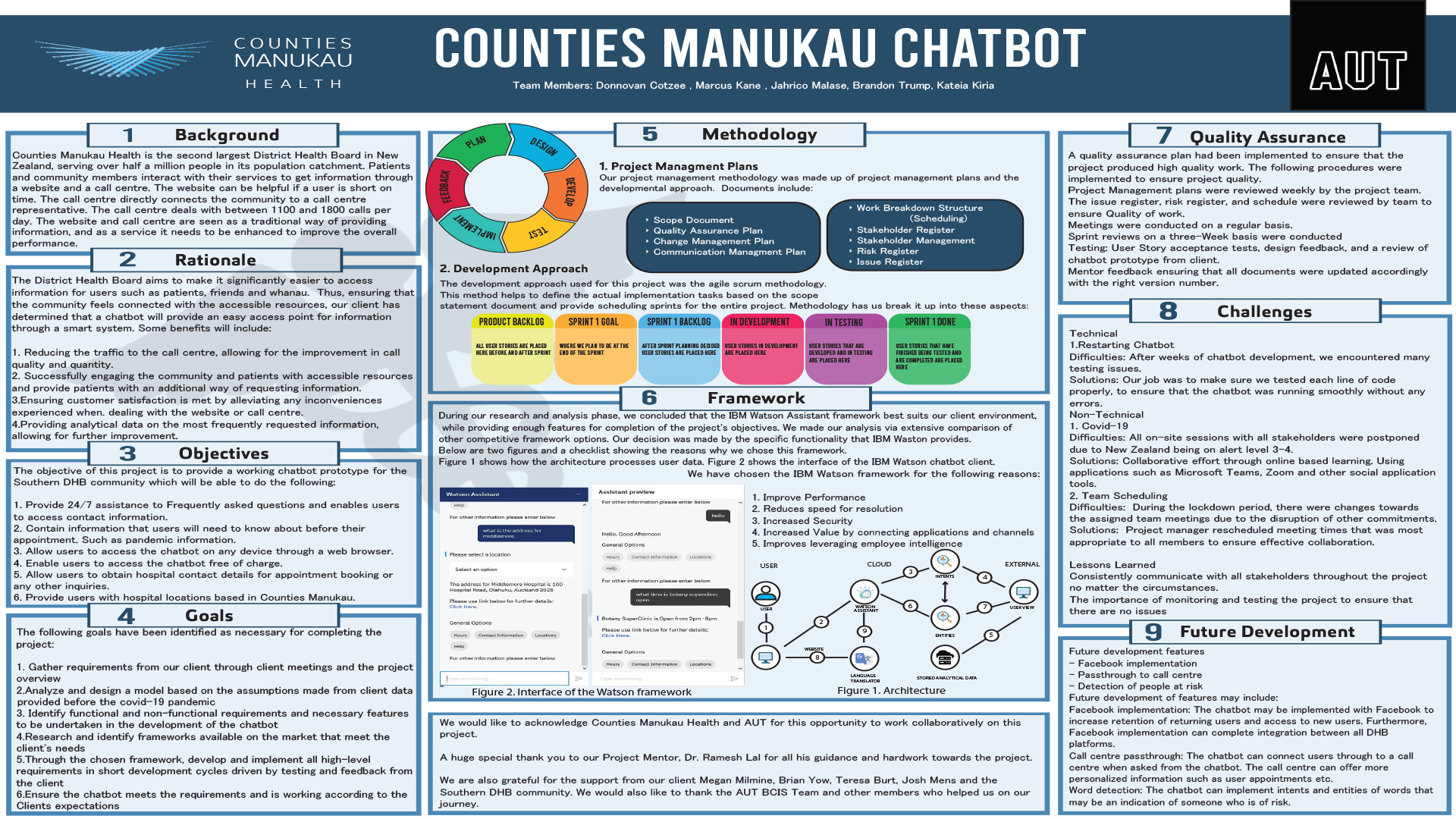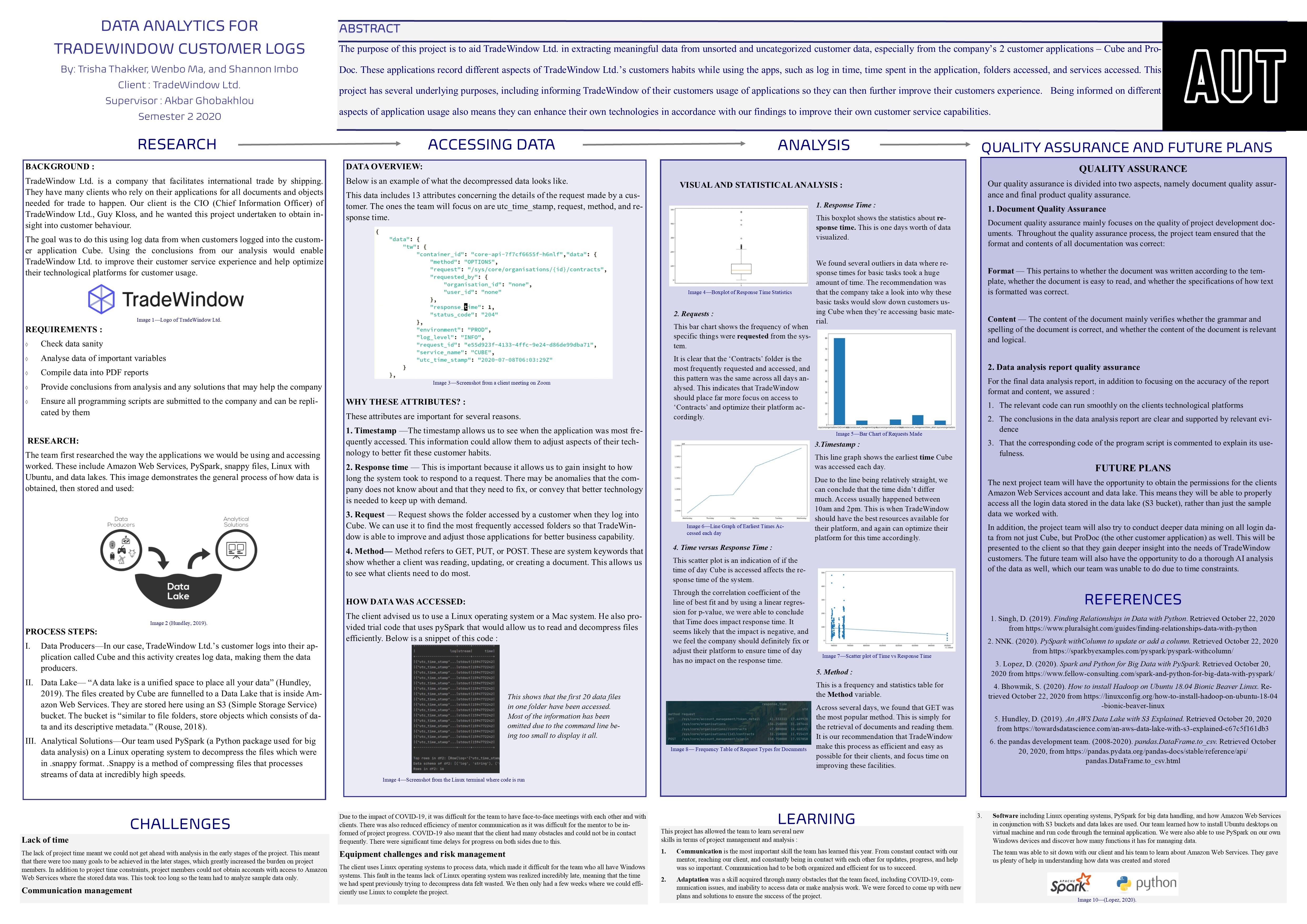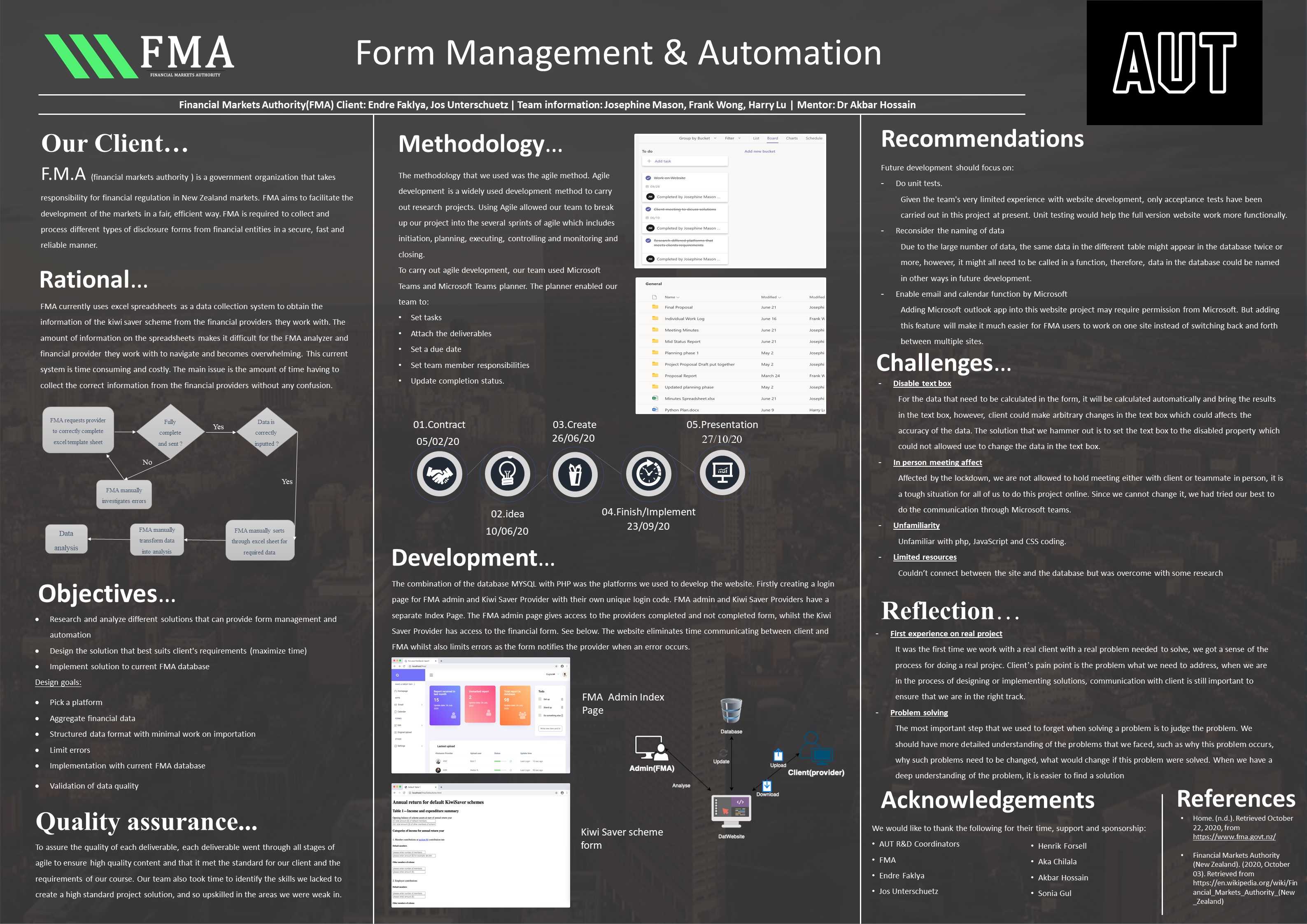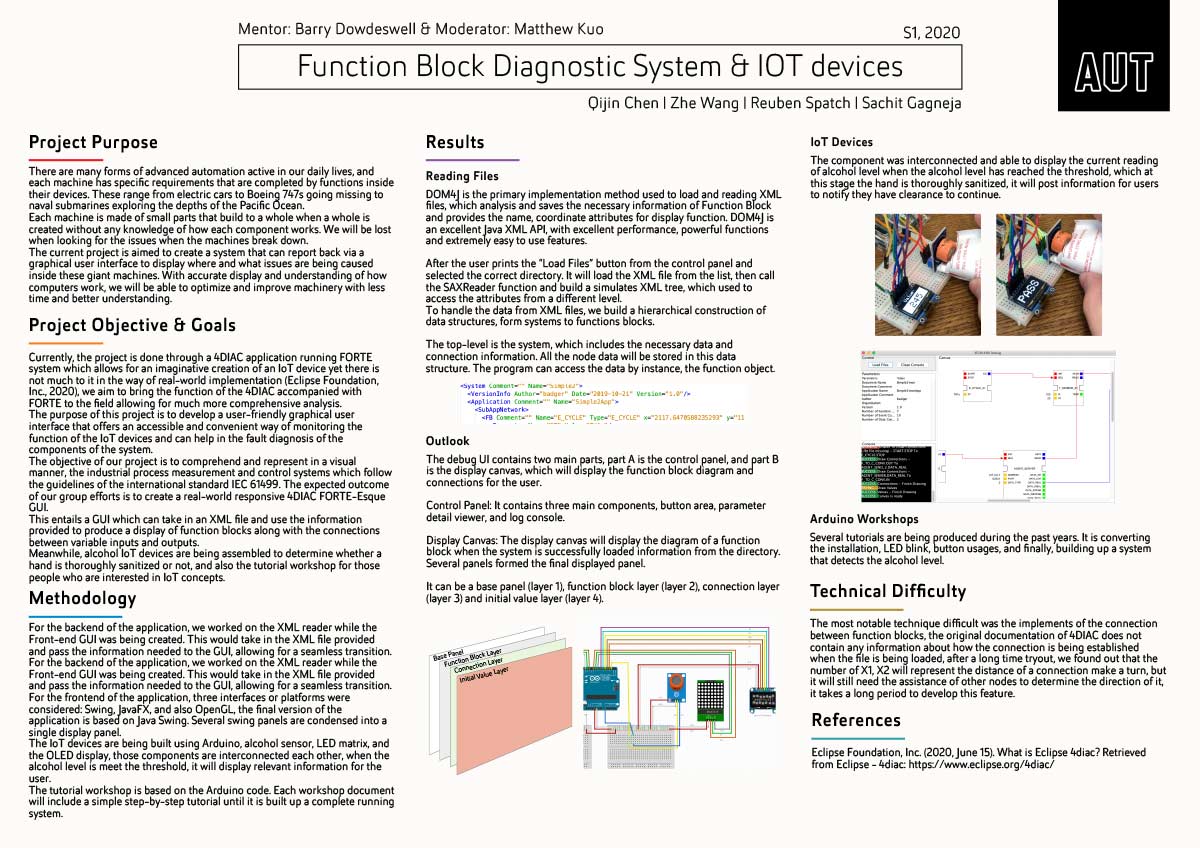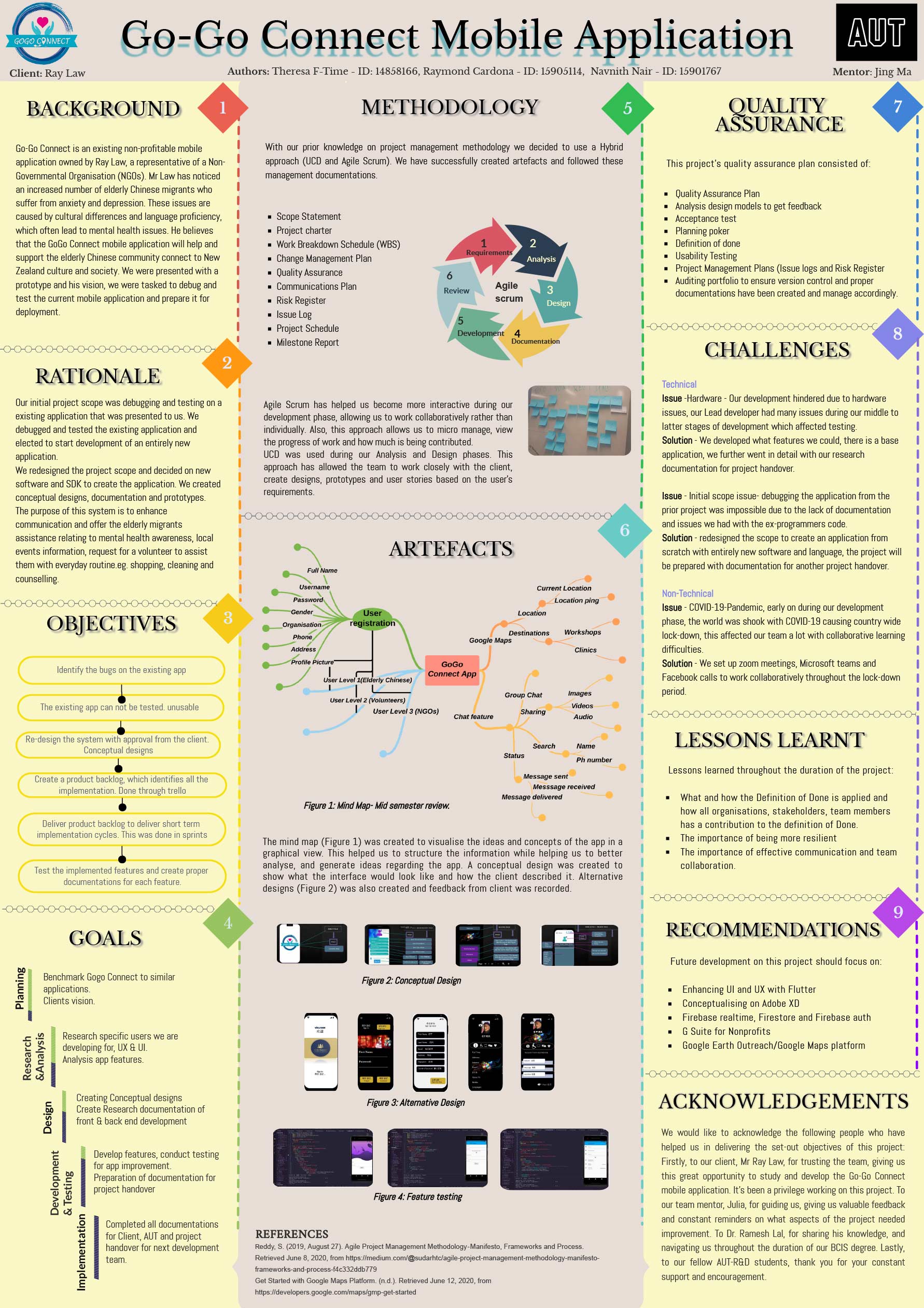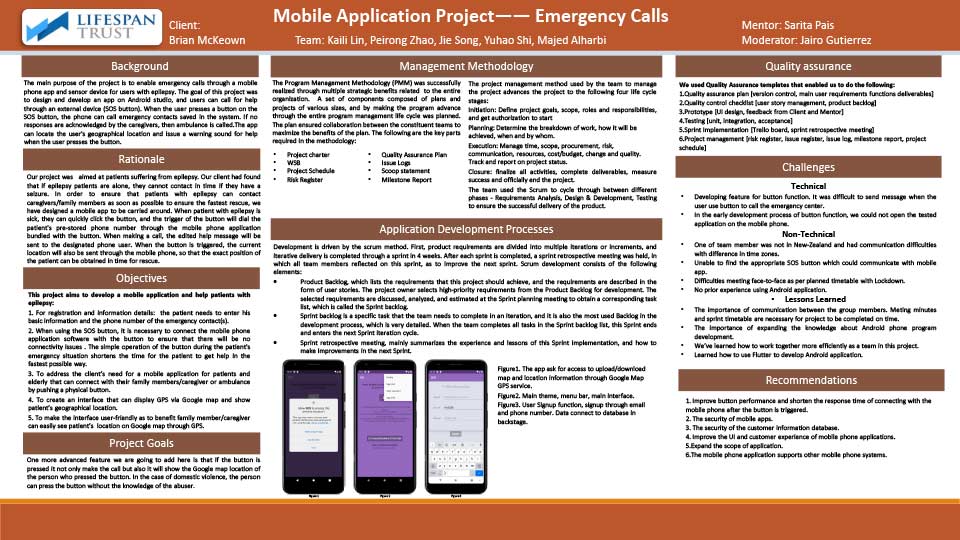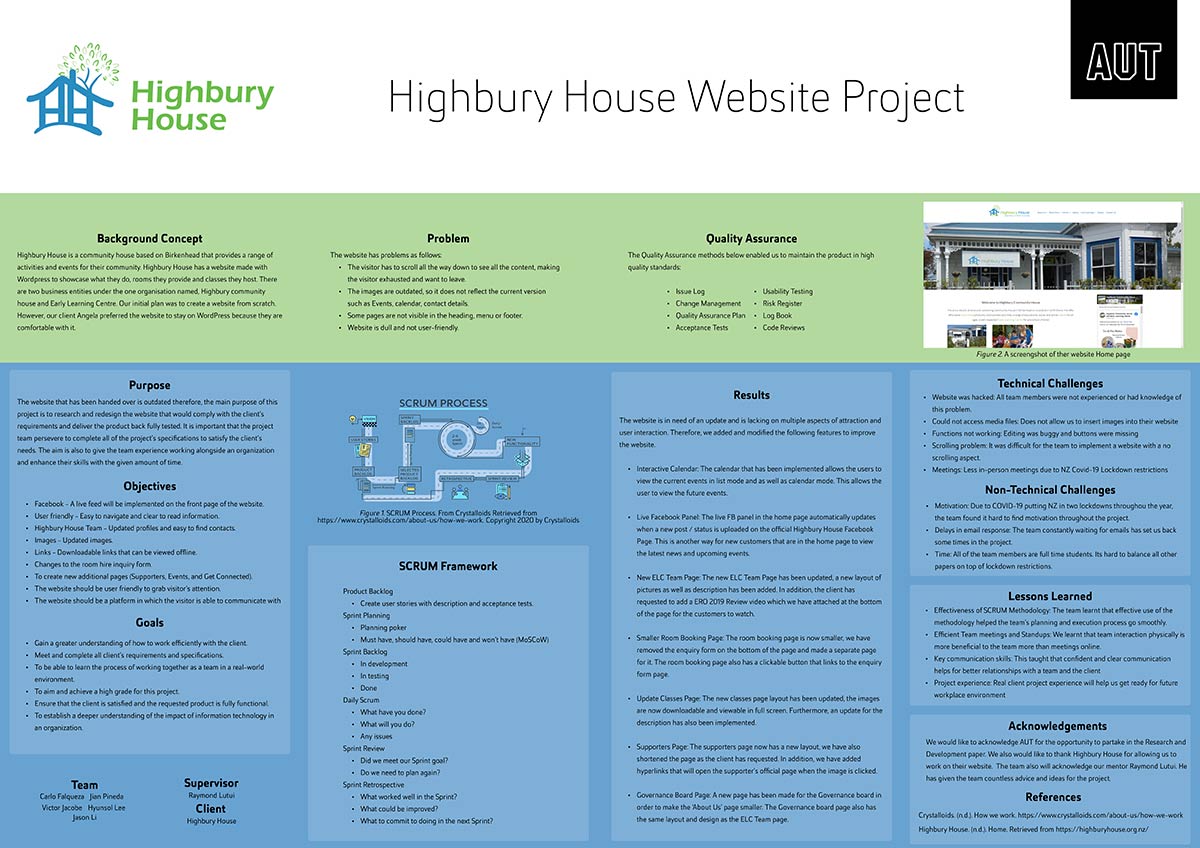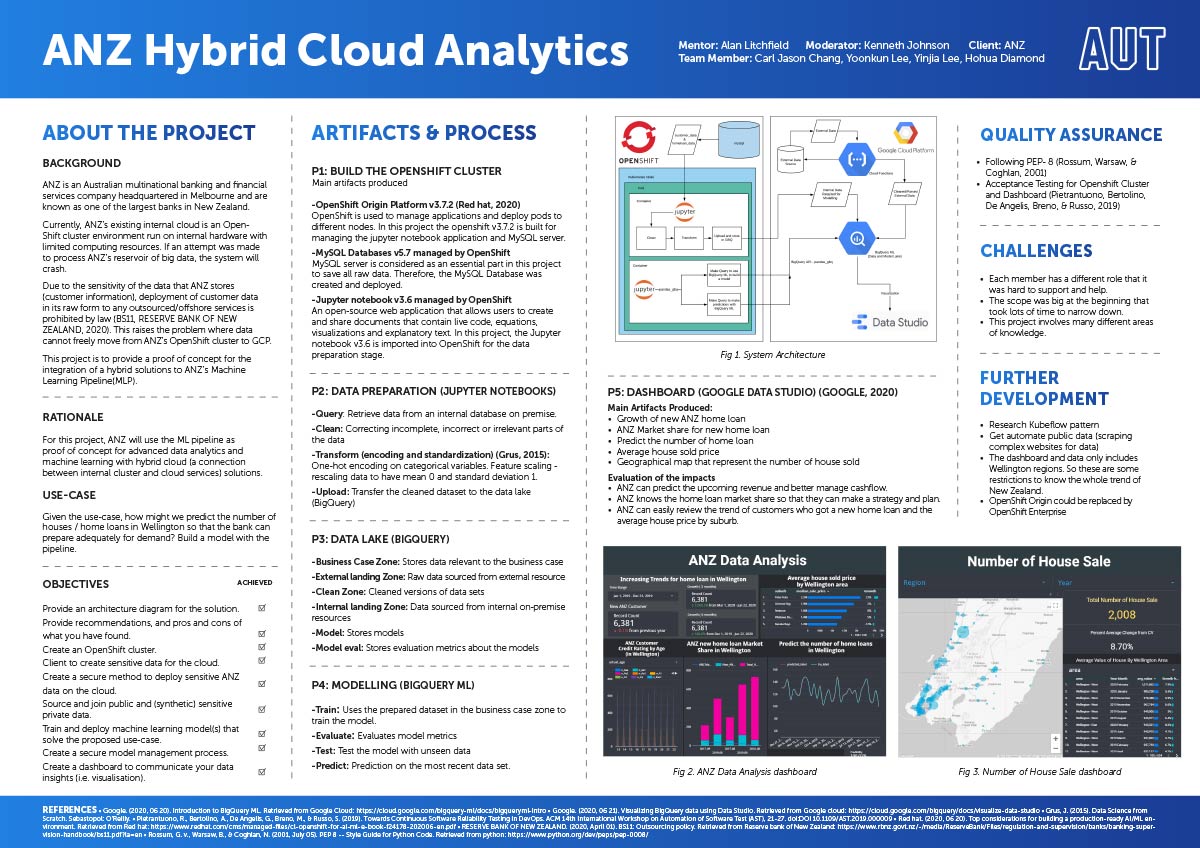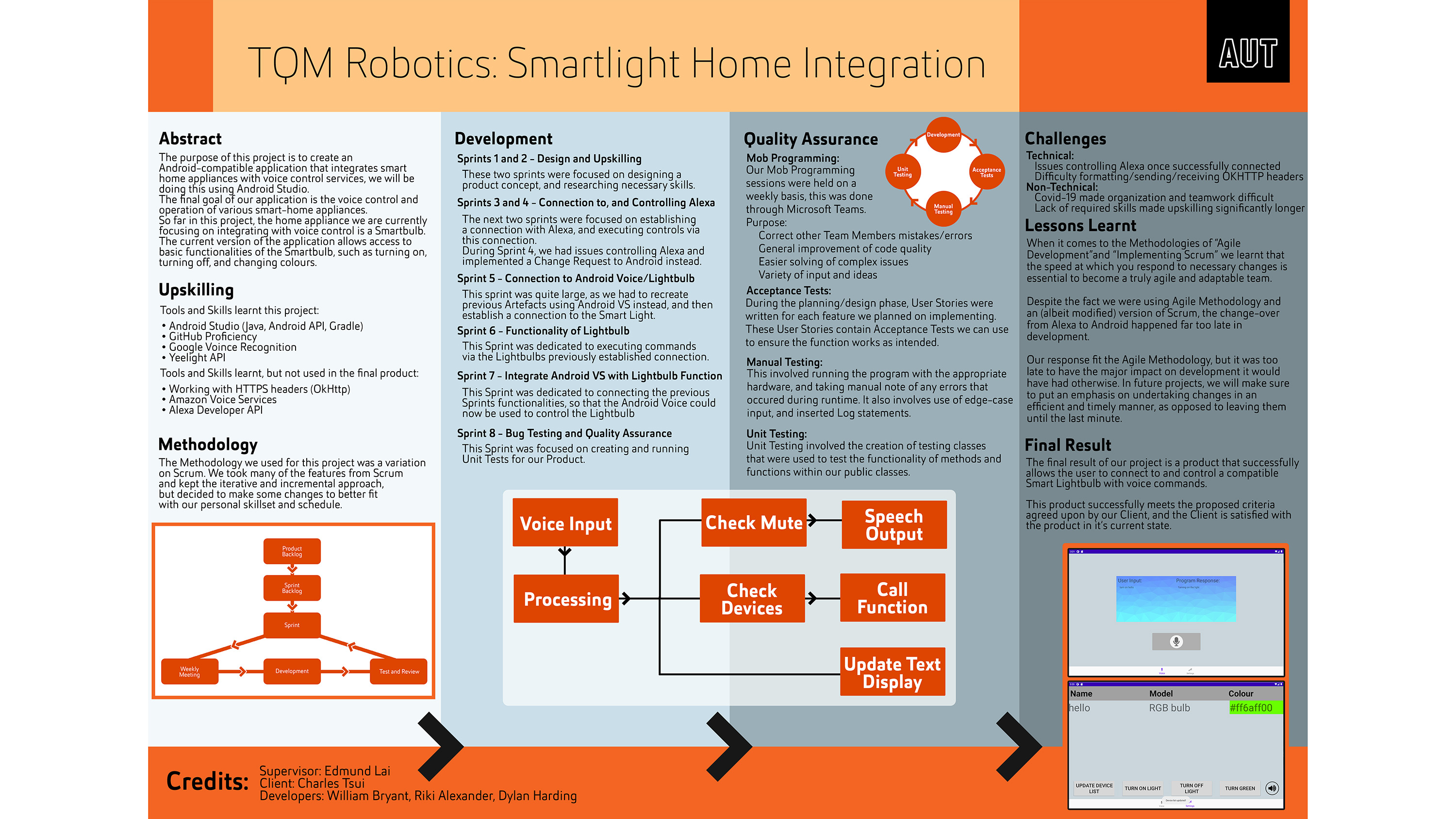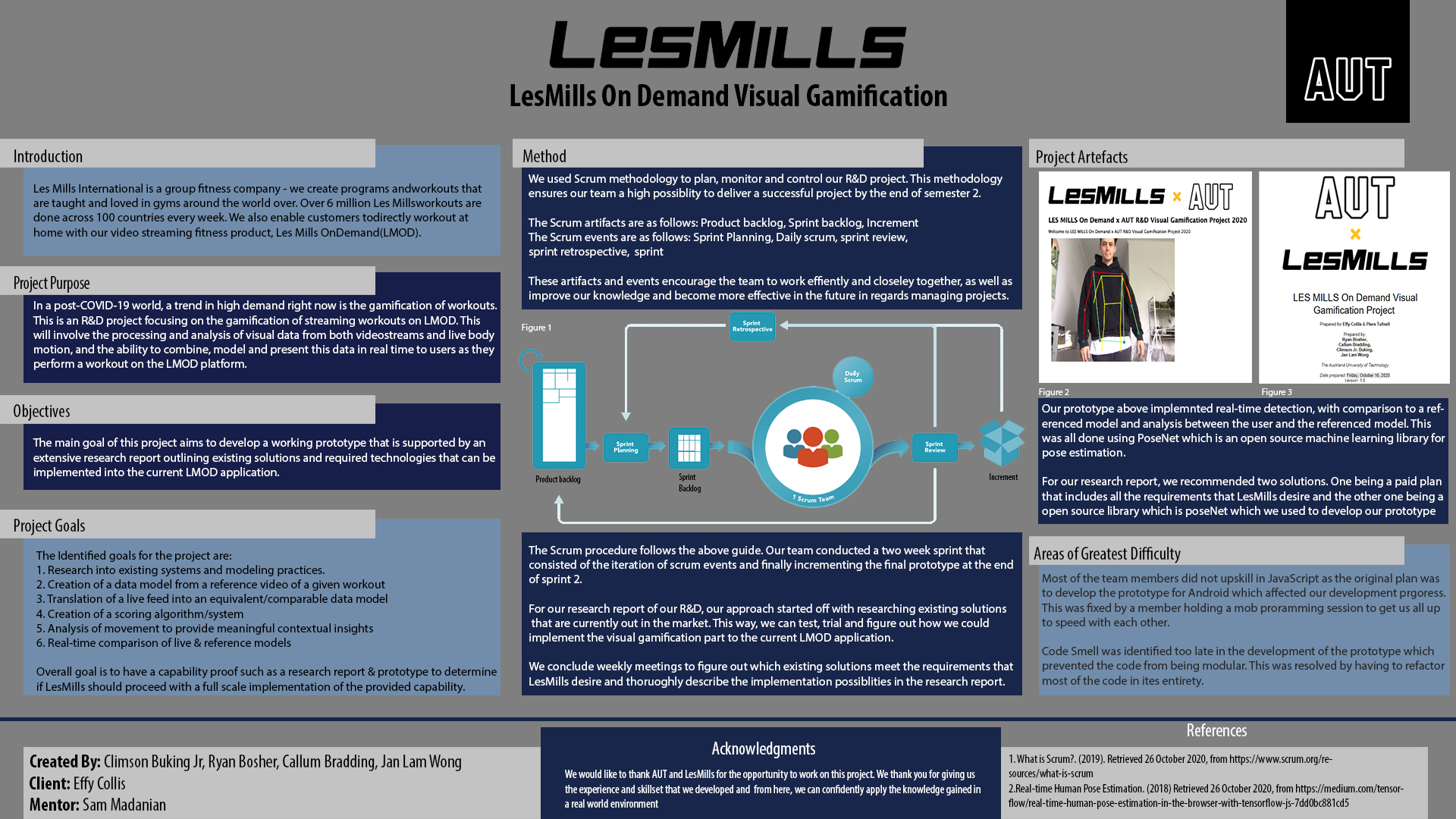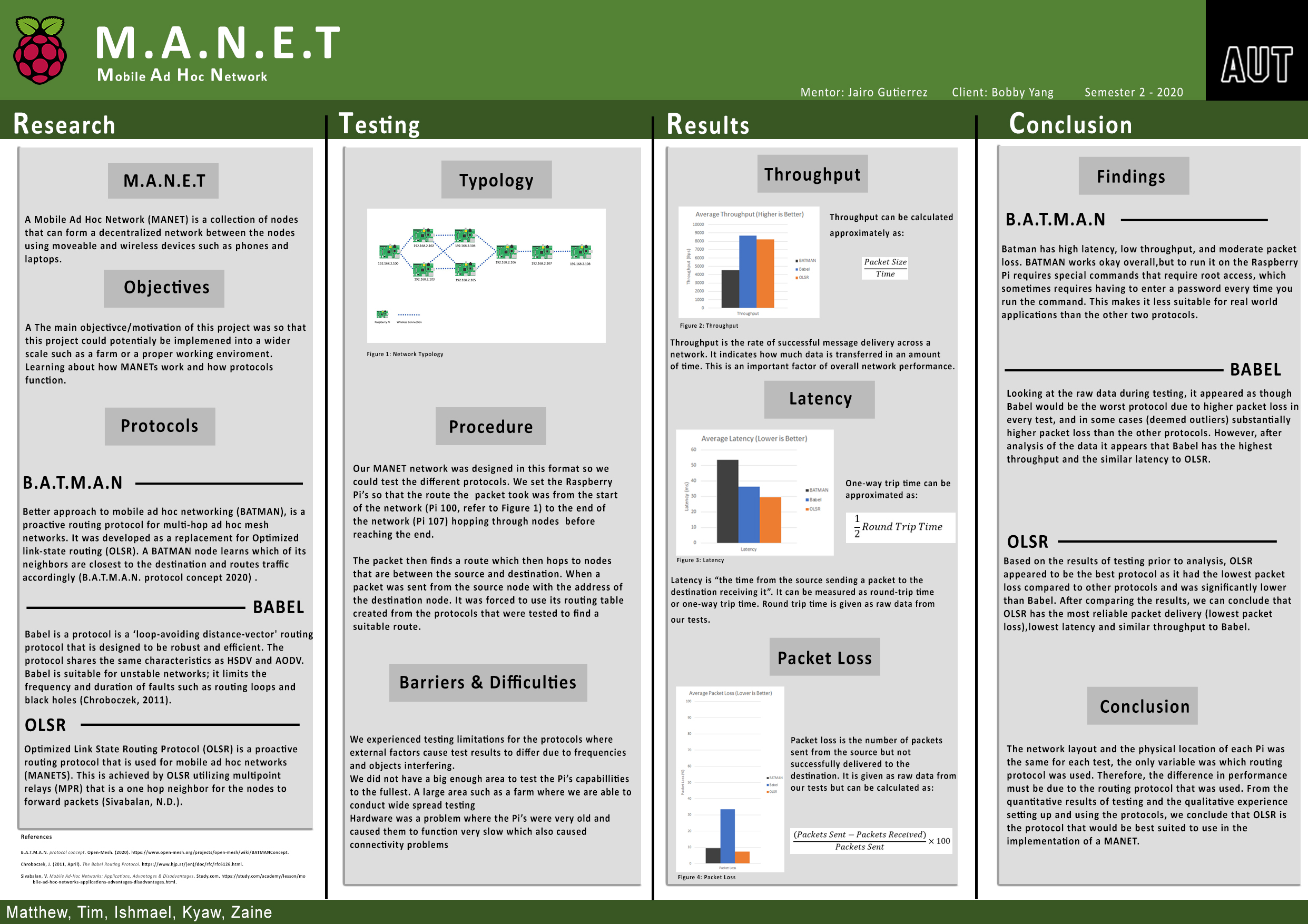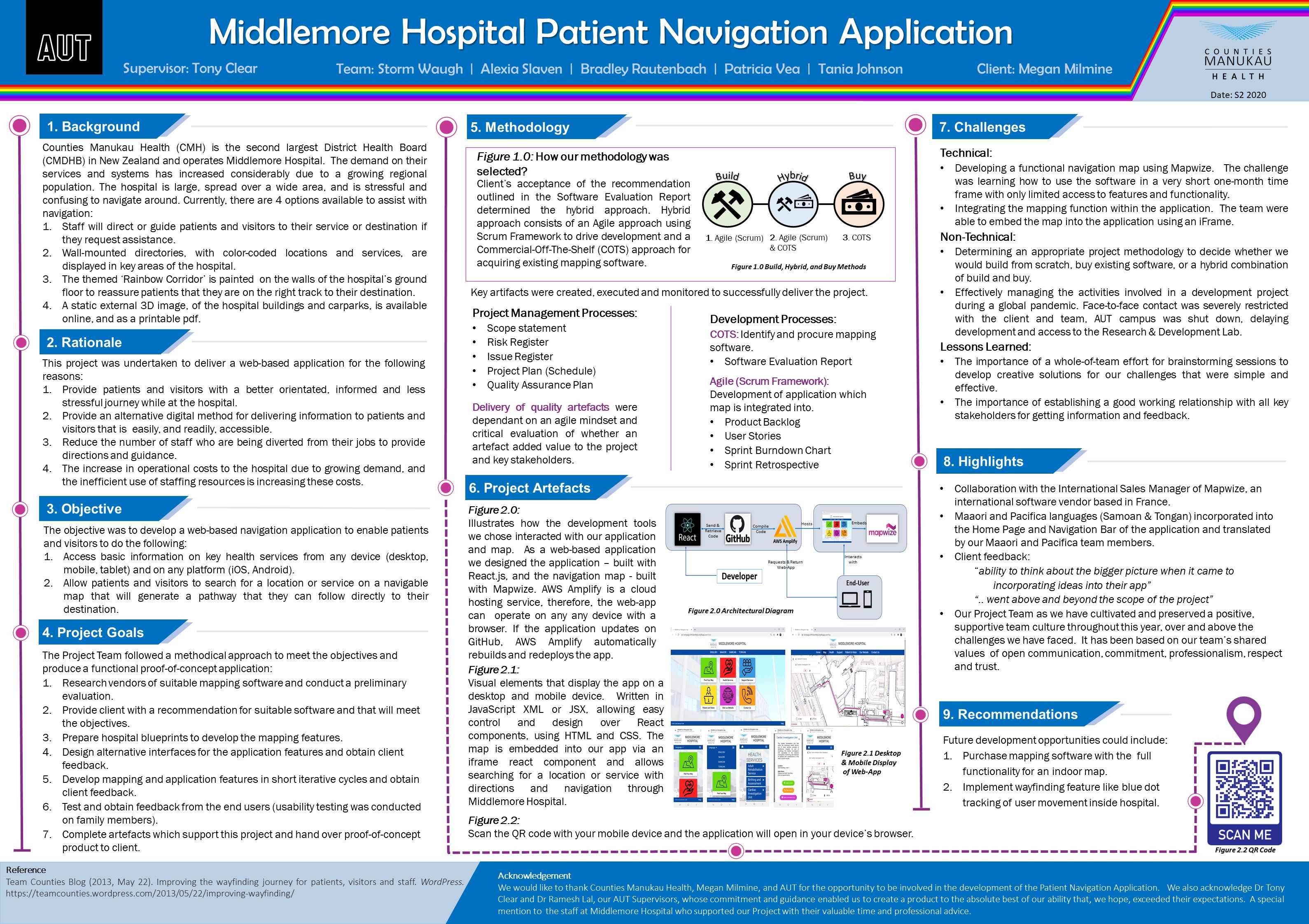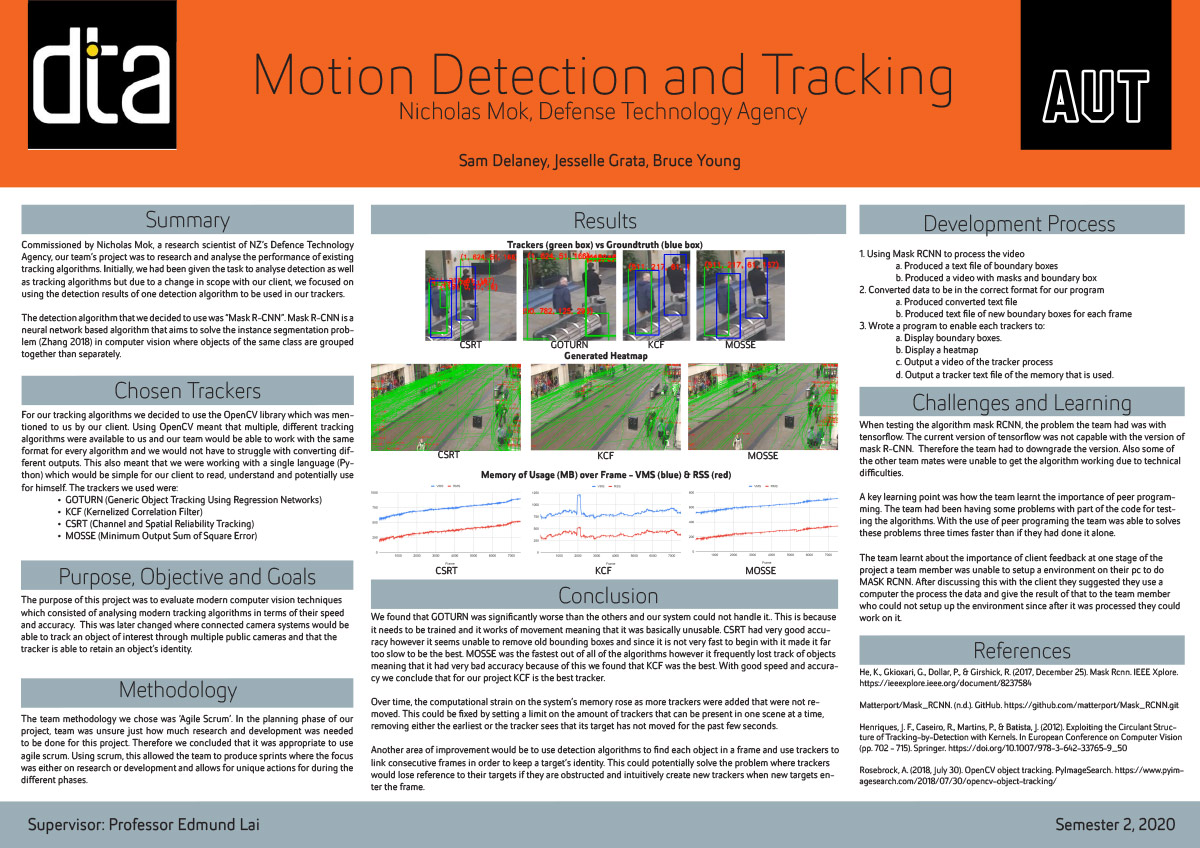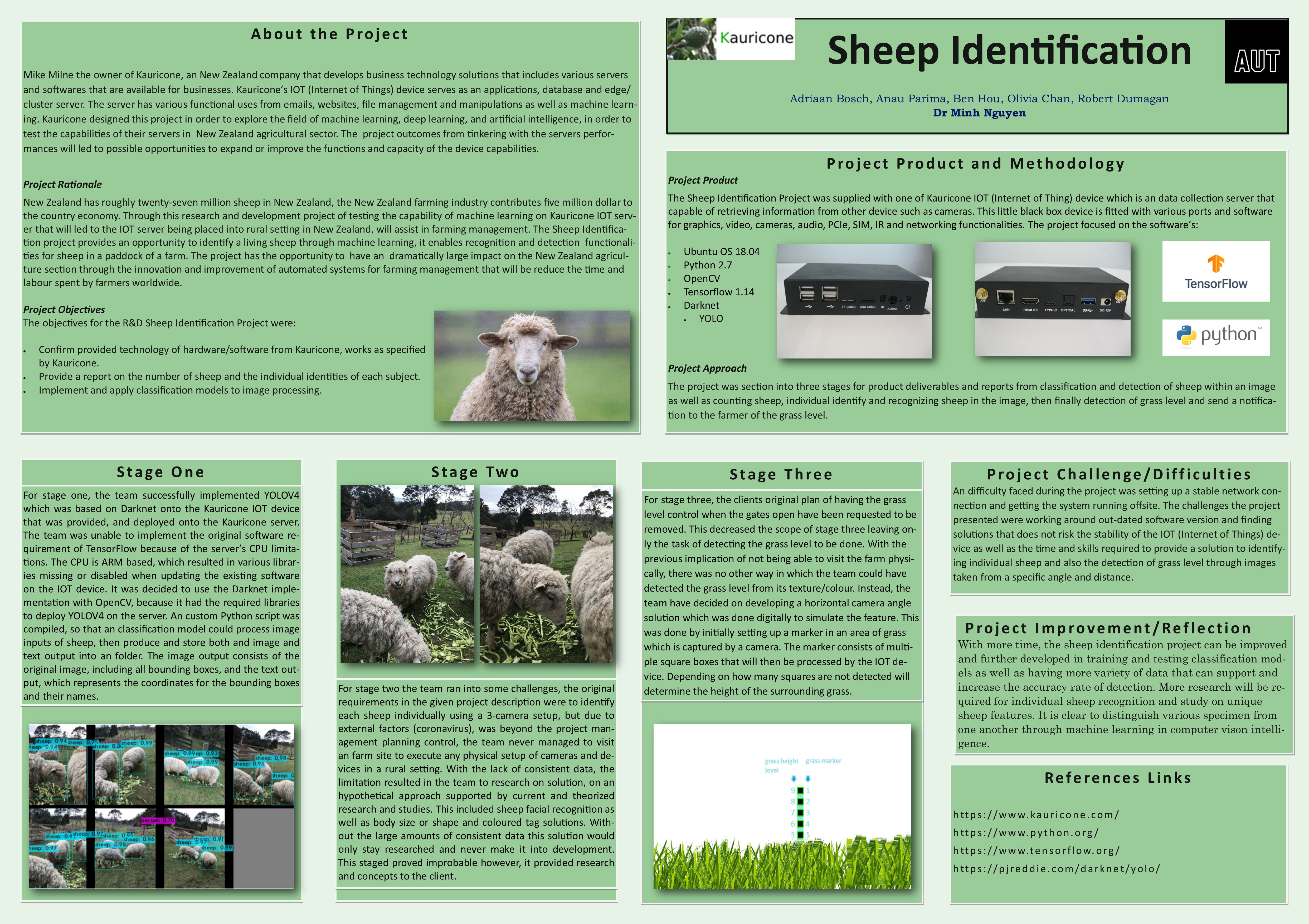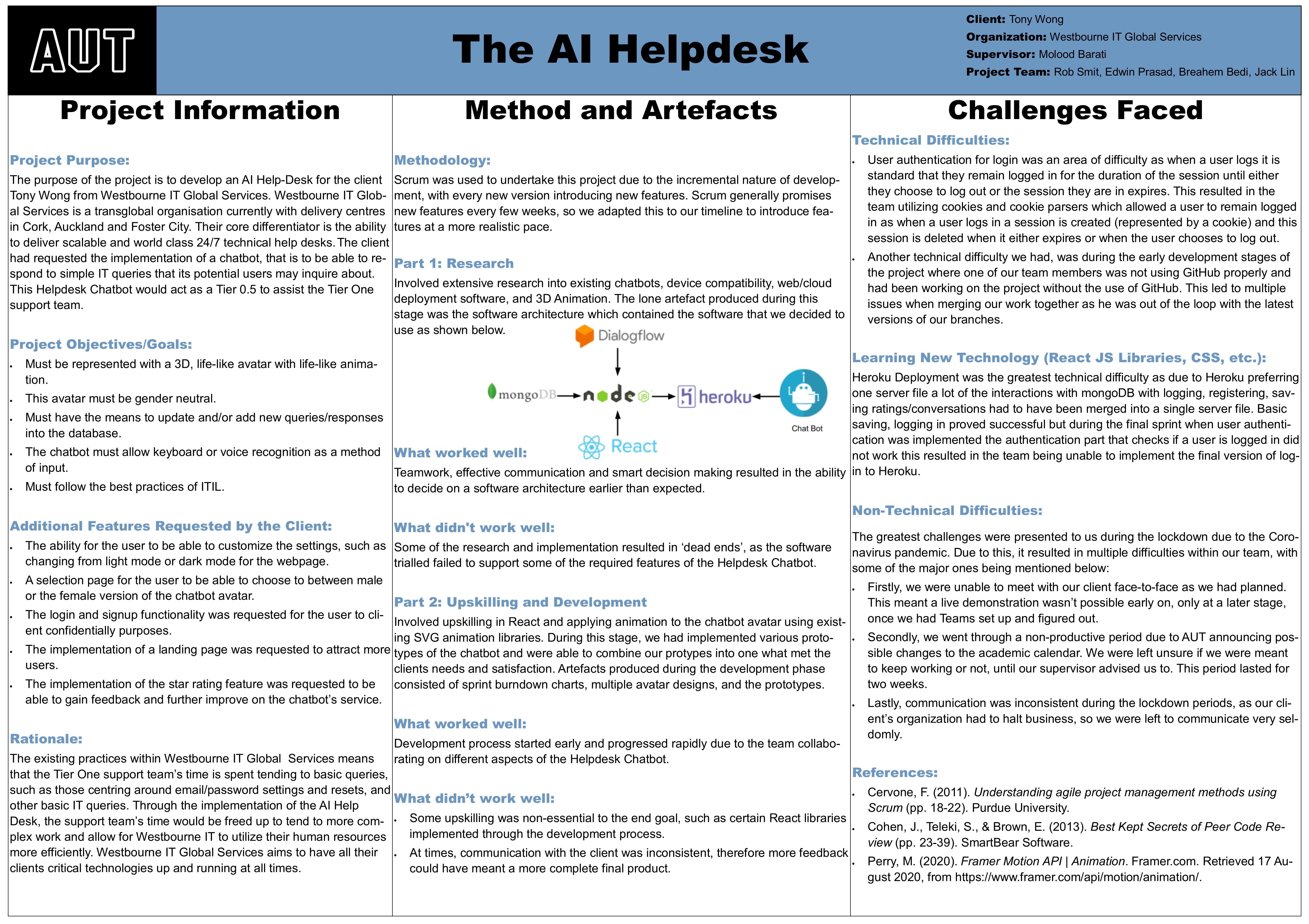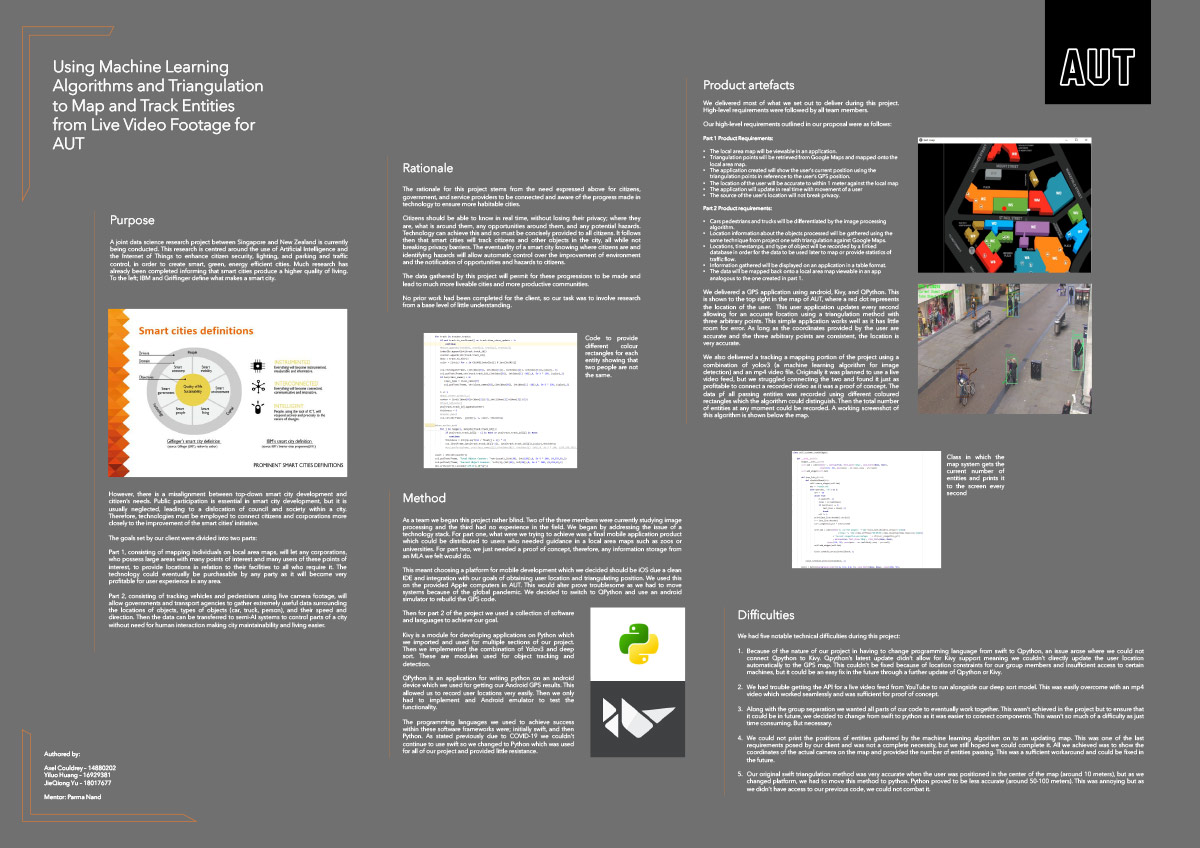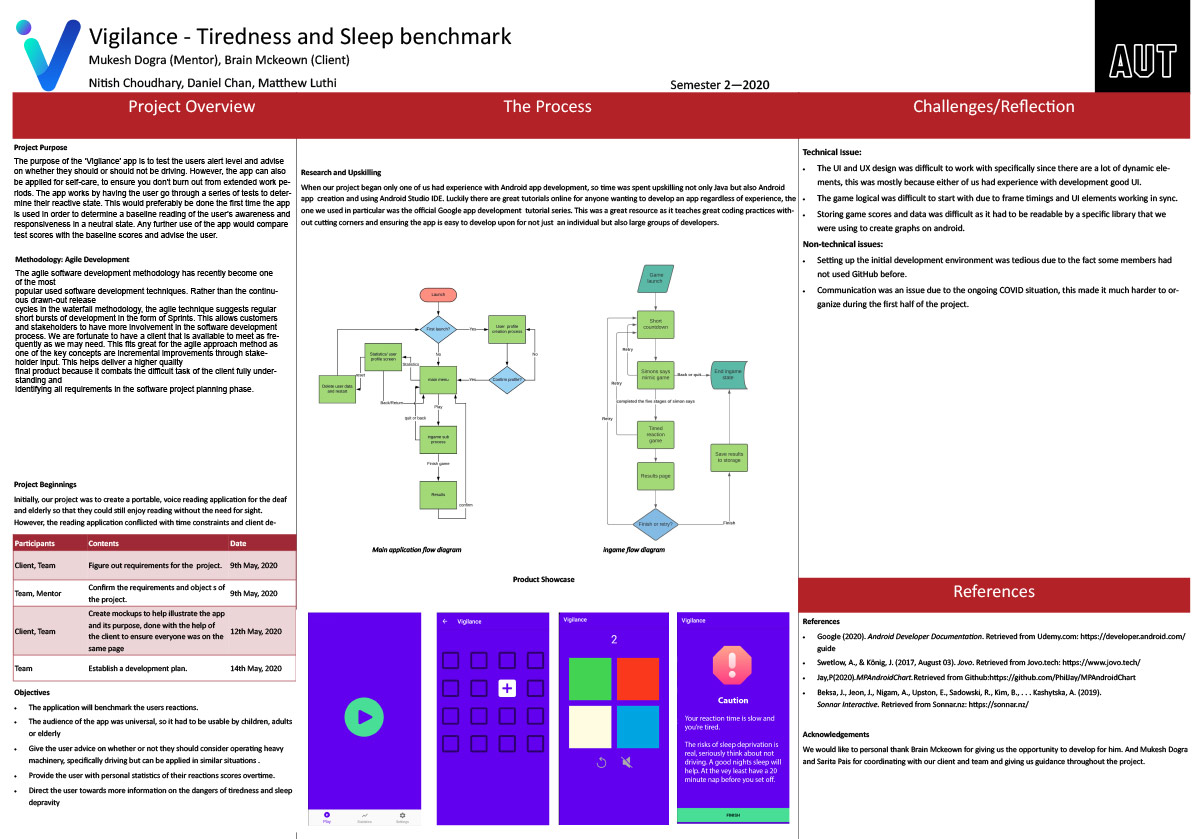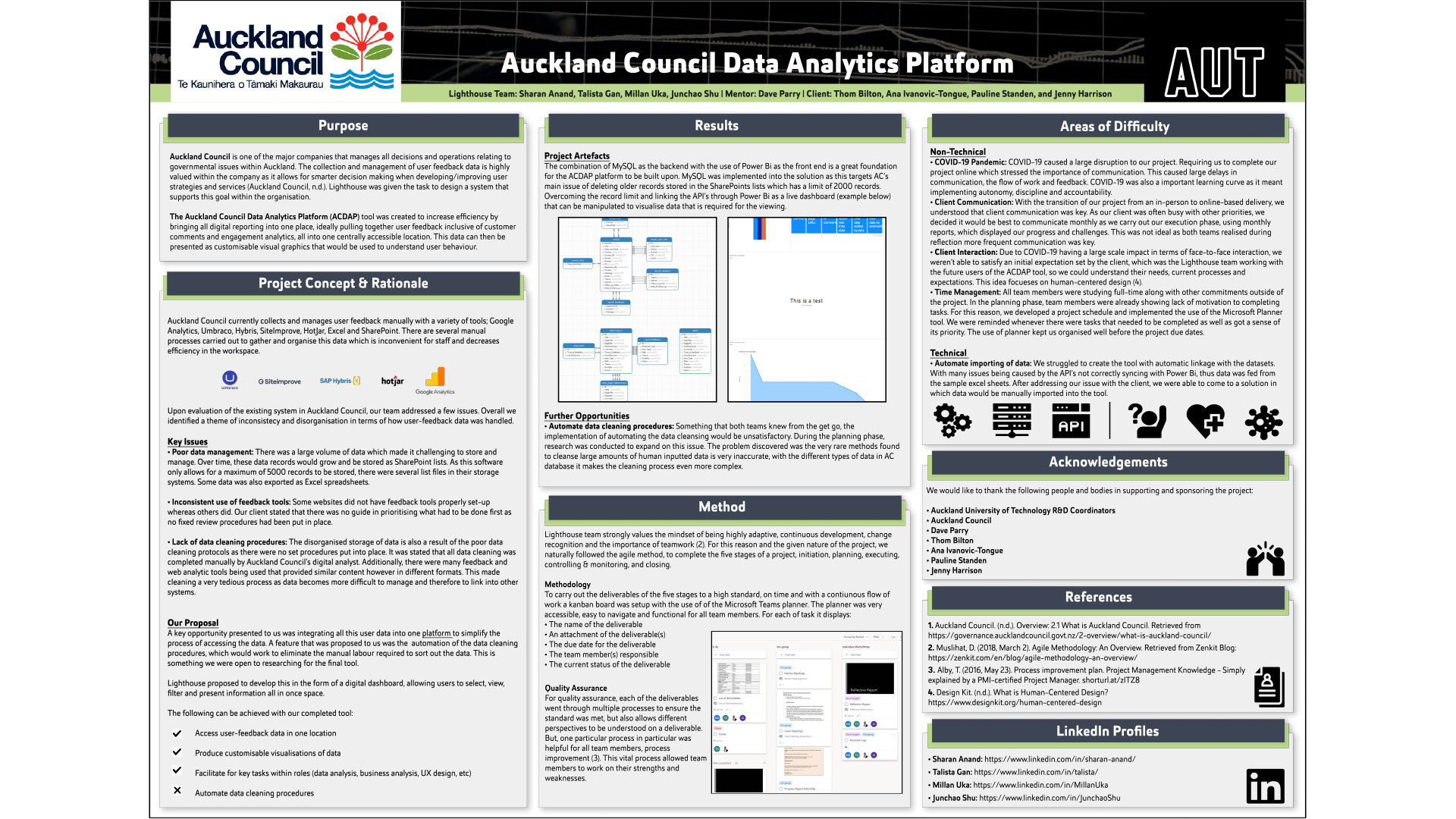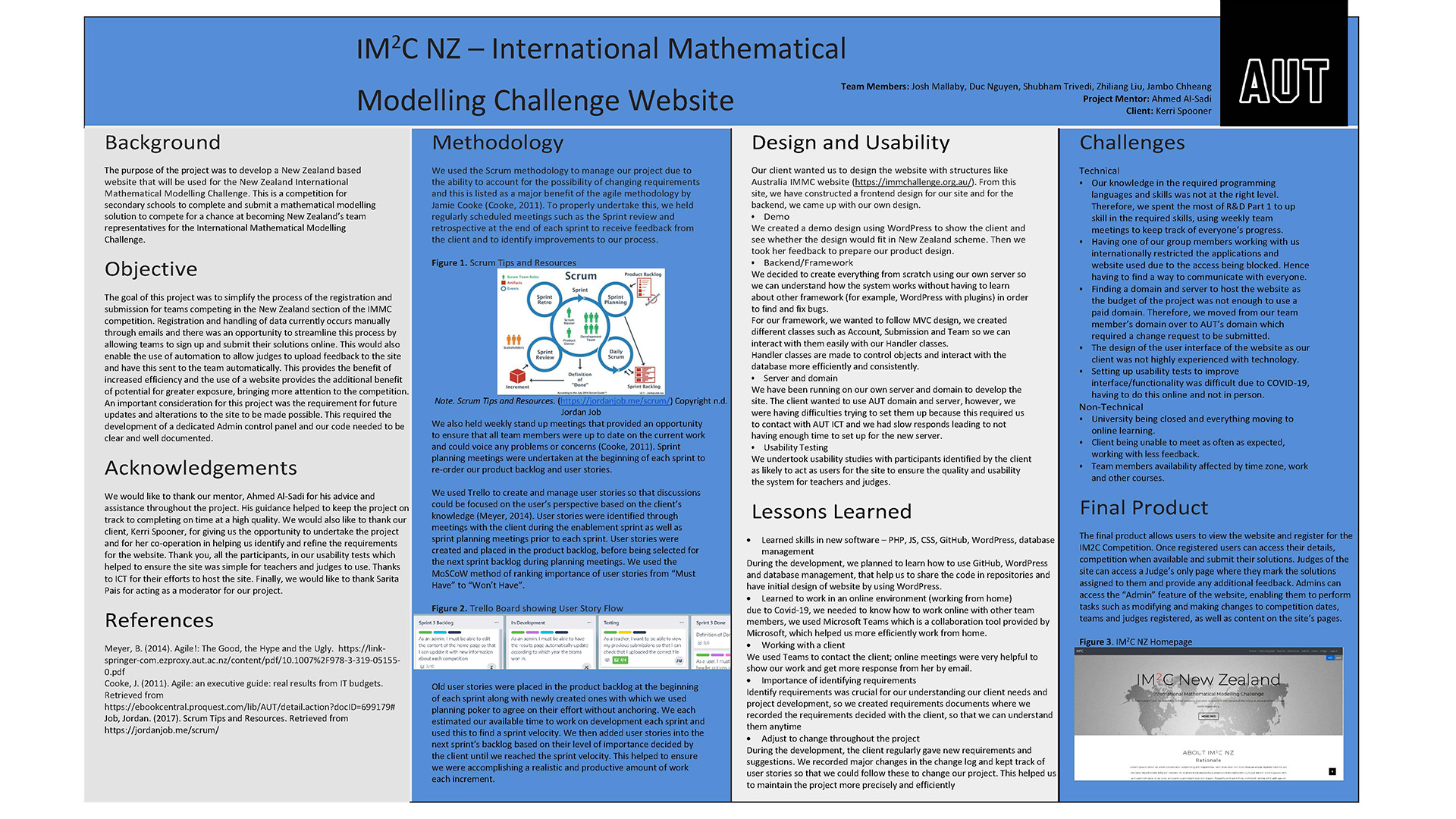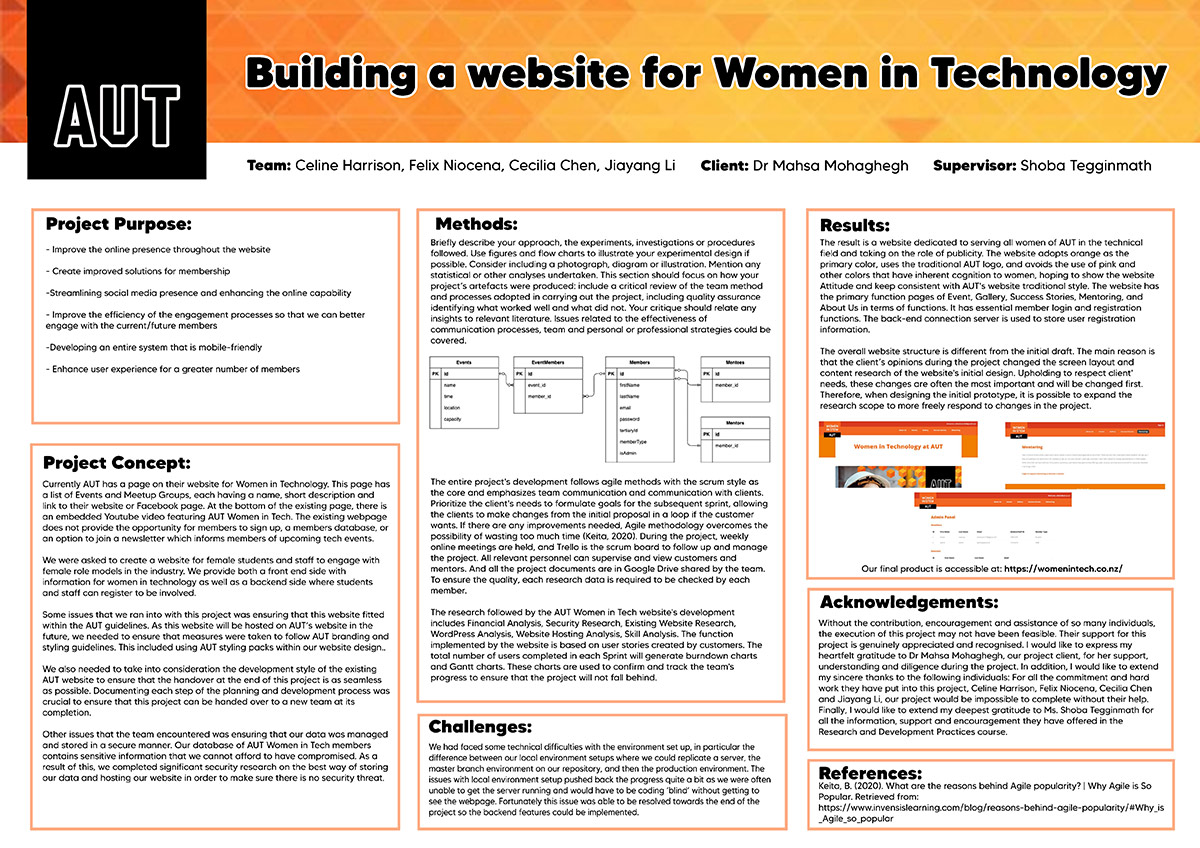Student showcase from Bachelor of Computer and Information Sciences 2020
Bachelor of Computer and Information Science students work on a real-life industry project as part of their final year in the areas of Software Development, Computer Sciences, Computational Intelligence, IT Service Science, Network and Security and Analytics. The course prepares our students for careers spanning from telecommunications to education and healthcare to finance.
We hope you enjoy the showcase and we encourage you to connect with our students through their LinkedIn profiles.
Aider is a digital assistant for small businesses, that mimics a chat interface to provide accurate business information in a digestible format to small business owners. Our goal was to demonstrate an integration between Aider and Google My Business. The prototype shows how Aider can integrate with Google to provide accurate information to small business owners and allow users to manage their business listings. It provides functionality for users to view and manage the media posted to their business listing, view reviews and respond with custom or template responses, manage or add new template responses, and view or edit their opening hours. Managing a business listing on the prototype instantly updates the live listing on Google, allowing business owners to effortlessly manage their online presence.
Student(s)
- Ashley Groves
Bachelor of Computer and Information Sciences - Luke Wyeth
Bachelor of Computer and Information Sciences - Cheryl Cheng
Bachelor of Computer and Information Sciences
Supervisor
- Weihua Li
Mentor
- Aider (James Kukard and Vinay Singh)
Developing a cross-platform mobile application for A Few Quiet Yarns (AFQY) event management founded by Ryan Ashton. AFQY is a networking event that is primarily targeted to CIOs and CTOs but is open to anyone. It has a strict “no selling” rule so the attendees can form meaningful connections without the worry of sales pitches. The main purpose of the app is to help facilitate making connections at his events through these three key features. First is to display events along with their detail, second is to display attendees and their interests of each events, and finally a chat feature for attendees to have conversation before and after an event.
Student(s)
- Liam McAteer
Bachelor of Computer and Information Sciences - Rachel Lee
Bachelor of Computer and Information Sciences - Bonita Ryda
Bachelor of Computer and Information Sciences - Afton Lim
Bachelor of Computer and Information Sciences
Supervisor
- Livia Krstic
Mentor
- Ryan Ashton AFQY
The aim of this project was to prepare a final report that identifies and describes use cases for applying AI as a cybersecurity defence mechanism in medium to large sized organisations. The targeted audience comprises IT and Information Security managers in a middle to large organization who need to be updated on the topic.
The requirements of the report were to consider and discuss, in some depth, AI methods and approaches that can be implemented in the use cases identified, their practical implantation and feasibility, and also issues and challenges related to them. It also needed to be written from the perspective of a security analyst.
Due to the nature of our project, we used the Qualitative Research Method alongside Critical Analysis. Qualitative Research is the collection of non-numerical data (e.g. text/use cases) to understand concepts, experiences or opinions. Based on the amount of relevant data found, each specific use case was carefully chosen and analyzed to publish the company background, challenges, implementation/feasibility and the benefits and/or issues.
There was no specific format for the report to be written in, therefore as a team we created the format for the final report which includes: Title Page, Contents, Executive Summary, Introduction, Literature Review, 40 use cases (which explore the company background, challenges, implementation/feasibility, benefits and/or issues), Recommendations, Conclusions and References.
Our project poster illustrates four main phases: Initiation, Planning, Implementation and Quality Assurance. It also includes the overall project challenges and learnings. These steps helped us to get along with our project and ensure every step was processed on time.
Initiation: The project manager and the project team arranged a meeting to discuss the basic information about our project and team roles. Then we met with our client and mentor, they came up with ideas and Suggestions for our project.
Planning: We decided as a team to utilize Trello and the Gantt chart as Project Management Tools. We scheduled Team meetings once every week on Fridays, scheduled meetings with our mentor every 2-3 weeks and our client once or twice per semester. We discussed which communication platform would be suitable for our team and tasks were also allocated out equally.
Implementation: Team meetings took place every once week where meeting minutes and agendas were done before and after every meeting. Ongoing tasks were updated every time there were any changes. Tasks would be put up on Trello and it would be moved to the ‘DONE’ section once each task was completed. Our main source of research was sourced from the AUT Library and also Google scholar.
Quality Assurance: We ensured that the case studies chosen for our report were top quality with enough relevant data to analyze and decided as a team to aim for a maximum of 50 Use Cases/Case studies. This enabled us to write an in depth report with ‘quality over quantity’ in mind. To maintain the quality of our documentation and report we made sure we submitted it to our mentor 1-2weeks prior to the due date so that we could get some feedback and make changes if and where needed. We also published a research and report guideline to ensure that we as a team are researching valid information for our report.
Project Challenges and Learnings: Throughout our project, we were able to learn about AI for Cyber Security and its benefits of use in this modern day, specifically for medium to large sized organisations. Along the way we learnt new research skills and were able to work well in a team to share our knowledge and produce a well researched report to present to our client. We also learned about the amount of medium to large organizations that are actually utilising Artificial Intelligence within their organisation as a Cyber security defence mechanism.
Student(s)
- Melaia Korobure
Bachelor of Computer and Information Sciences - Saara Naseri
Bachelor of Computer and Information Sciences - Holmes Zhou
Bachelor of Computer and Information Sciences - Faris Almutawa
Bachelor of Computer and Information Sciences
Supervisor
- Krassie Petrova
Mentor
- Jairo Guiterrez
The purpose of this project is to build a Blockchain Web Wiki for our client (Jeff Nijsse). which contains information about blockchain and various other related topics. The main purpose of this Wiki is to will help the user to understand and compare research of blockchain although it will also have minor additions such as a hierarchy of roles with adjusted permissions to edit, add, delete and comment on specific pages or information available on the website. The pages are to have a simple and clear design and reputable sources. We are to have a taxonomy to categorize the consensus method of blockchain, an account system that can verify trusted users and a mailbox system that can receive notifications. The data will be represented by text and graphs, these texts and graphs can only be accessed by user accounts following the role hierarchy. One of our main goals was to make this website easily accessible and visually appealing for users.
Student(s)
- Krinesh Shah
Bachelor of Computer Information Sciences - Dingguang Lyu
Bachelor of Computer Information Sciences - Shixuan Wang
Bachelor of Computer Information Sciences - Jason Chung
Bachelor of Computer Sciences
Mentor
- Alan Litchfield
Industry sponsor
- Jeff Nijsse
CAITO has been one of the leaders in developing enterprise solutions using cognitive AI. Their technology enables people to access unstructured data in a contextualized and organized fashion, which can all be done using natural language powered by NLP. The CAITO Knowledge Repository is a project which allows individuals and teams to gather massive data (including documents, Youtube videos, news, etc.) and access only the information relevant to their query written in natural language. The project was developed using React (Web), Flutter (Mobile), and Firebase (Backend). The team used a modified version of Scrum to overcome the constraints associated with being full-time students.
Student(s)
- Cameron Guthrie
Bachelor of Computer and Information Sciences - Jerry Kim
Bachelor of Computer and Information Sciences - Jordie Muljana
Bachelor of Computer and Information Sciences - Logan Warner
Bachelor of Computer and Information Sciences - Tristam Archer
Bachelor of Computer and Information Sciences
Supervisor
- Weihua Li
Industry sponsor
- CBA Strategic IT
This was a Collaboration between AUT and Counties Manukau Health to create a working chatbot. Currently the only way patients & community members may obtain answers to any medical related questions is to call the call centre. However, the issue with this is that users must sit in a queue and wait to be answered. This wastes time and can create stress. The purpose of our project is to develop a chatbot that will work via website application. The chatbot will provide 24/7 assistance to the patients and community with frequently asked questions and other health information. In turn the chatbot will reduce the traffic directed to the call centre and provide users with immediate answers to their questions.
Student(s)
- Donovan Coetzee
Bachelor of Computer and Information Sciences - Marcus Kane
Bachelor of Computer and Information Sciences - Brandon Trump
Bachelor of Computer and Information Sciences - Jahrico Malase
Bachelor of Computer and Information Sciences - Kateia Kiria
Bachelor of Computer and Information Sciences
Supervisor
- Ramesh Lal
Mentor
- Megan Milmine
Industry sponsor
- Counties Manukau Health
The ‘Data Analytics for a Digital Trade Platform’ project was given to our team by TradeWindow Ltd. TradeWindow Ltd. is a company that facilitates trade and exchange for importers and exporters through shipping. They build tools to advance the process of trade, such as certificates of origin, letters of credit, blockchains, digitized document creation, and standardized document creation. TradeWindow has hundreds of customers using their software for these exact purposes so that they can export and import easily between themselves and their export partners. They are a global business with offices in New Zealand, China, Australia, and Singapore, meaning that the must keep all technology and systems as efficient as possible for global use. This project aimed to perform data analysis on Big Data produced by TradeWindow Ltd. The purpose of this was so that the company could gain insight into their customers’ behaviour and patterns. These insights in turn would allow them to optimize their technological platforms and services for their customers, as well as the company’s own efficiency. For example, if we were to find that the most usage of their platforms was between 1 and 3pm, we could advise that they optimise the platform for that time, and devote less resources to it at other times. Our analysis could also point out several system faults, areas of improvement, and establish important patterns that could help the company not only make the system more efficient for customers, but also efficient for themselves. A correct optimization of their technology could mean that TradeWindow Ltd. is able to work better internally. The data was compiled from the customer application “Cube”. Cube allows clients to “manage communications, documents and data insights from one platform” (https://www.tradewindow.io/). This makes trade incredibly efficient, as different companies using the application have direct communication with their export partners. They can make decisions at a faster rate, thereby saving time and money. Cube is also excellent for its secure nature – while all data is very well managed and permissioned, it can also be shared safely with those who need it. It is one of the company’s most important applications, a large number of data is collected from it. When a customer logs into Cube and makes a request, that request is recorded and then funnelled into a data lake. Due to the number of requests made each day, this amount of data is incredibly huge and what we call ‘Big Data’. Big data can be incredibly hard to work with, and so through our clients’ suggestion, we were advised to use a Python package called PySpark. This would help us easily decompress all the data and then manipulate it for all our analysis. The two most important methods of analysis during the course of this project was statistical and visual. The team used regressions to find relationships between variables and analysed the patterns of individual variables over the course of many days to establish whether any trends were present within the data. These helped us draw conclusions that will inform TradeWindow Ltd. on their clients habits, just as we set out to do. Through our analysis of this dataset, we were able to investigate several important variables, namely requests, timestamp, response time, and method. This gave insight as to what TradeWindow clients wanted access to the most (e.g. contracts, account management), when they log in, how long the system took to respond to their requests, and what clients actually do with what they’re accessing (whether they’re viewing, updating, or creating documents). The final result of our analysis was the creation of several PDF reports of visual and statistical analysis, along with the associated conclusions and solutions the team had for the company. All evidence was clearly outlined in our product, along with an associated explanation as to why we thought this was important for the company to know.While this project had its associated obstacles and challenges, the team was able to learn a lot about how data is stored, created, and works in a practical context for a company. We had the chance to work with real data and gain insights that we hope will help TradeWindow Ltd., both in the short and long term.
Student(s)
- Shannon Imbo
Bachelor of Computer and Information Science - Trisha Thakker
Bachelor of Computer and Information Science - Wenbo Ma
Bachelor of Computer and Information Science
Mentor
- Akbar Ghobakhlou
Industry sponsor
- TradeWindow Ltd
This teams project was to create an Android application for Fiserv to allow flexible creation and management of staff social events for authorized staff and all allow any staff to easily browse and sign up for events and manage their own bookings. Role-based restrictions allow for increased security when employees create an event. This is done by login function where the roles have access to certain features. Improved accessibility by allowing access to the system outside work premises. Providing reporting information for organisers of events, such as attendance. We were tasked to develop a system that has less friction and enhanced functionality for users to manage staff social events.
Student(s)
- Jazmin Vagha
Bachelor of Computer and Information Sciences
Supervisor
- Jim Buchan
Mentor
- Oliver Furneaux
Industry sponsor
- Fiserv
In this project proposal, we are aiming to discuss, provide a framework and form and idea of the project’s feasibility. Requirements will also be included to developing the project. For this project, our goal is to find out different solution options that can create and design digital forms for financial providers working with FMA (our client). The financial providers will provide information based on their Kiwi saver scheme to the digital form in which it can be automatically analysed, transformed and sorted to the platform following FMA’s requirements. We will also compare the different solutions and choose the best suited to FMA’s expectations.Our client Financial Markets Authority (FMA) is a government organization that take responsibility for regulating financial market, they aim to facilitate the development of the markets in a fair, efficient way. FMA is required to collect and process different types of disclosure forms from Financial Entities in a secure, fast and reliable manner. The scope of this project is to investigate existing opportunities to design digital forms that will be readily processed through FMA’s database. The solution should enable FMA to send disclosure requests to entities in a secure and reliable way, and enable fast, reliable and secure data communication with financial entities. FMA expects for there to be automated data and analytic ready information which is why the project has been launched. Being automated and analytic ready would ensure the data collection process to speed up, and provide consistency and reliability thus reducing time, costs and confusion of any missing information, extra information or errors. FMA also requires the solution to be cloud based in order to prevent data loss and to ensure data security.A very important function is that this website will require user to Register their own account and each client/company will only be able to have one account to help them fill and submit their Kiwisaver form to FMA. There will be two SQL database links to the website and FMA will be the administrator of this website and database to view and control users account and forms. Once FMA’s client has created an account. The system will be given a unique user id and all the id & password & user’s detail will be save in one database – “Account Database”. In this database, user id will become the primary key that classify different users account and information. After user sign in, they will be able to fill the Kiwisaver application form on the website. Everything they have input; it will be able to save into the second database – “Form Database”. We will set up format and examples to help users fill the forms. We will also set up the same format for data in database which will highly improve the data accuracy and quality. For safety issues, two databases will sit outside of FMA internal database. However, FMA will be able to access, call or translate it by users’ unique ID. We will also think a way to set up very strict password for website server and database server to protect data and FMA internal server.
Student(s)
- Josephine Mason
Bachelor of Computer and Information Science - Harry Lu
Bachelor of Computer and Information Science - Frank Wong
Bachelor of Computer and Information Science;
Mentor
- Akbar Hossain
Industry sponsor
- Financial Market Authority
The aim of our project is to comprehend and represent in a visual manner the industrial process measurement and control systems which follows the guidelines of the international standard IEC 61499.
In addition, we have also created an IoT device which detects the remaining alcohol on the hand and visualize whether the hand is fully sanitized or not, this is quite useful when facing flu and the situation like COVID-19. further, we have also created a series of Arduino tutorial courses for the person who would willing to learn the basics of Arduino coding.
Student(s)
- Sachit Gagneja
Bachelor of Computer and Information Science - Reuben Spatch
Bachelor of Computer and Information Science - Qijin Chen
Bachelor of Computer and Information Science; - Zhe Wang
Bachelor of Computer and Information Science;
Supervisor
- Matthew Kuo
Mentor
- Barry Dowdeswell
Originally our project objective was to debug, test and fix an existing application that Ray Law had, we went about debugging and determined that the software and current application was not suffice for what our client was intending. We made a change request to redevelop the project from the ground up including analysis, research, documentation and development.
Project key objectives:
- User groups and personas
- Determine features
- Research and document features
- Develop and prototype features
We went about doing a deep dive on Ray Laws application, determine the user groups and what features will be assigned to each individual user, how they would interact with the feature and the features will be interacting with other user groups. We created research documentation on each individual feature with a in depth guide including purpose of feature, research, problems, Implementation, and activity of implementation into development. We went about learning the SDK Flutter and the coding language dart, during our development phase we tested and prototyped individual features but were unable to create a fully functioning prototype. We prepared all documentation for project handover for another development team to take up as was our agreement with the client.
Student(s)
- Navnith Nair
- Theresa Fagaese-Time
- Raymond Cardona
- Zhang Shiqi
Supervisor
- Jing Ma
Industry sponsor
- Ray Law
Our project is to design and develop an application on the Android platform. Users can use this app to call emergency contacts for help through SOS button. Also can send Messages to family when user presses the SOS button. User can cancel the emergency call when user presses the SOS button twice. The app can show the user real-time location, with alarm for help when user presses SOS button. Our users are mainly epilepsy patients. Our client has found that if epilepsy patients are alone, they cannot get help in time if they have a seizure. In order to ensure that patients with epilepsy can get help as soon as possible, our client has designed a mobile app to be carried around. When users need help, they can click the button, and the trigger will dial the patient's emergency contact number. If the call did not answer, the SOS message with the user location will be sent to the emergency contact automatically.
Student(s)
- Kaili Lin
Bachelor of Computer and Information Sciences - Jie Song
Bachelor of Computer and Information Sciences - Majed Ebaid A Alharbi
Bachelor of Computer and Information Sciences - Peirong Zhao
Bachelor of Computer and Information Sciences - Yuhao Shi
Bachelor of Computer and Information Sciences
The project that has been given to the team is an important project for the organization. This project will require the team to redesign and rebuild a few aspects of the organization’s website. This website is significant for the organization as this is one of their assets to be recognized in the public which also gathers multiple customers from different regions.
The following list below are the original objectives and requirements that we needed to complete for this project:
- Redesign the ‘Home’ page.
- Update the ‘About us’ page.
- Update the ‘Classes’ page.
- Redesign the ‘Room Hire’ form.
- Redesign the ‘Our Team’ page.
- Add a ‘Gallery’ page.
- Add a ‘Supporters’ page.
- Add ‘Events/What’s Happening’ page.
- Add a 'Get Connected’ page.
Student(s)
- Carlo Falqueza
Bachelor of Computer and Information Sciences - Jian Pineda
Bachelor of Computer and Information Sciences - Victor Jacobe
Bachelor of Computer and Information Sciences - Hyun Sol Lee
Bachelor of Computer and Information Sciences - Jason Li
Bachelor of Computer and Information Sciences
Supervisor
- Raymond Lutui
Industry sponsor
- Highbury Community House
2019 S2 AUT initiated the Hybrid Cloud Analytics research and development project. Once the team was officially confirmed, the team enthusiasm initiated the project with engagement with the stakeholders. Creating the project workspace and the various communication channels. A workshop was agreed upon that would provide the team with a scope, objective and use cases. During this time, up-skilling was taken on-board on the cloud providers that were available. Amazon Web Services (AWS), Google Cloud Platform (GCP), Microsoft Azure. Clients also provided some on premise capabilities regarding infrastructure and software. Plus, preferred suppliers. Which narrow the vendors to AWS and GCP. Red Hat OpenShift Containerisation Platform and Python frameworks that are currently being used by the client. This provided the direction of the project.
Student(s)
- Carl Jason Chang
Bachelor of Computer and Information Sciences - Hohua Diamond
Bachelor of Computer and Information Sciences - Yinjia Lee
Bachelor of Computer and Information Sciences - Ryan Yoonkun Lee
Bachelor of Computer and Information Sciences
Supervisor
- Kenneth Johnson
Mentor
- Alan Litchfield
Industry sponsor
- ANZ Bank NZ
Our sponsor, TQM Robotics, would like us to develop an Android Application that can be used to control and operate a smart lightbulb using voice commands. Initially we proposed using Amazon’s Alexa to implement voice controls, but due to unforeseen issues we changed our focus to Android’s Voice Services midway through the project. The app was developed to integrate with Robot Temi for the purpose of attracting NZ customers. The initial scope of this project was the development of an application that allowed for the control of various smart appliances, but due to the time constraints of this project a smart lightbulb was chosen to act as the prototype device to establish a proof-of-concept.
Student(s)
- Rivenski Alexander
Bachelor of Computer and Information Sciences - William Bryant
Bachelor of Computer and Information Sciences - Dylan Harding
Bachelor of Computer and Information Sciences
Supervisor
- Jing Ma
Mentor
- Edmund Lai
Industry sponsor
- TQM Robotics (Charles Tsui)
This poster is a presentation of our LMODVG which covers the research report and the development of the prototype which were the main deliverables. The poster outlines the process of our development and how everything came in to place for our final product.
Student(s)
- Climson Buking Jr
Bachelor of Computer and Information - Ryan Bosher
Bachelor of Computer and Information - Callum Bradding
Bachelor of Computer and Information - Jan Lam Wong
Bachelor of Computer and Information Sciences
Supervisor
- Sam Madanian
Industry sponsor
- LesMills
Create a Mobile Ad-hoc Network (MANET) using 10 Raspberry Pi microcomputers, research and test different routing protocols and produce an academic report detailing our findings.
Student(s)
- Tim Mudford
Bachelor of Computer and Information Sciences - Ishmael Havea
Bachelor of Computer and Information Sciences - Matthew Ching
Bachelor of Computer and Information Sciences - Kyaw Win
Bachelor of Computer and Information Sciences - Zaine Mani
Bachelor of Computer and Information Sciences
Supervisor
- Jairo Gutierrez
Mentor
- Mee Loong (Bobby) Yang
Industry sponsor
- AUT
This Project was completed in collaboration with Counties Manukau Health with a proof-of-concept, web-based Patient Navigation Application developed for Middlemore Hospital. The application can run on all devices with a modern browser, and on iOS/Android platforms. We chose a hybrid approach for our methodology where we built the application component from scratch, and the navigation/mapping component using available software. Mapwize, an international vendor based in France, had the software we required for the mapping component. Project highlights were implementing the key languages for Middlemore, giving patients and visitors the ability to access key health service information from any device, and working on a real industry project with a supportive and responsive client.
Student(s)
- Tania Johnson
Bachelor of Computer and Information Sciences - Storm Waugh
Bachelor of Computer and Information Sciences - Alexia Slaven
Bachelor of Computer and Information Sciences - Patricia Vea
Bachelor of Computer and Information Sciences - Bradley Rautenbach
Bachelor of Computer and Information Sciences
Supervisor
- Tony Clear
Mentor
- Deputy CIO, Megan Milmine
Industry sponsor
- Counties Manukau Health – Middlemore Hospital
This project is an analysis of trackers. The Trackers we used are Kernelized Correlation Filter (KCF) ,Channel and Special Reliability Tracking (CSRT), Generic Object Tracking Using Regression network (GOTURN), and Minimum Output Of Squared Error (MOOSE). The project’s objective is to determine if the trackers are able to retain the ID of the objects inside of a video. The team has written a program in Python using opencv2 libraries to test the tracker in how well they preform with the guidance of the algorithm Mask-RCNN by providing the tracking starting points.
Student(s)
- Jesselle Grata
Bachelor of Computer and Information Sciences - Sam Delaney
Bachelor of Computer and Information Sciences - Bruce Young
Bachelor of Computer and Information Sciences
Supervisor
- Edmund Lai
Mentor
- Nicholas Mok
Industry sponsor
- Defense Technology Agency (DTA)
This project was undertaken by the AUT student project team starting in February 2020 and finishing in November 2020. The students were required to develop a software solution to satisfy the business needs of Onsend, a start-up logistics and technology company that began operating in November 2019. Onsend needed a system to monitor the current locations of their delivery fleet and capture important route information to improve operations. The scope of the project was to research and rationalise potential technologies and solutions, and then design and develop a set of services to achieve vehicle tracking and confidently estimate arrival times. This system consists of an Android mobile application, a web interface, and an API backend. The mobile app is to reside with the delivery driver whilst they are on their delivery route, to capture the vehicle location and other route details. The API manages the location and route data received from the mobile application and stores this data in a database. The web interface displays all the vehicle locations on a map and allows the user to search for current and historical routes, and view route information.The students adopted an agile Scrum framework to manage project objectives and tasks. Regular meetings and reviews were held to discuss product increments refine project requirements as business needs evolved. Control and management tools such as Trello, Azure DevOps, and Slack were used to improve communication, workflows, and testing. Tools utilised for the design process included Pencil project to produce the mobile app wireframes, and Swagger for the documentation of the API design. The students were encouraged to maintain best practices working with the respective technologies. Adopted technologies include React Native for the mobile application, Vue.js for the web interface, and ASP.NET Core for the API. Many challenges were faced by the team during this project, including working remotely from home due to the COVID-19 lockdowns. In contrast, there were many learning opportunities presented by the Onsend team. These opportunities involved working with an experienced project sponsor to guide the team with technical and non-technical advice and working with a professional designer to prototype the UI design for the web interface. This was crucial to the learning process and allowed the students to develop many different skills. The team would like to give a huge thanks to Craig Wilson and the team from Onsend for all the opportunities and support they have provided.
Student(s)
- Kane Brogan
Bachelor of Computer and Information Sciences - James Eason
Bachelor of Computer and Information Sciences - Zak Herman
Bachelor of Computer and Information Sciences - Hamish Kendall
Bachelor of Computer and Information Sciences
Supervisor
- Jing Ma
Mentor
- Craig Wilson
Industry sponsor
- Onsend
The R&D Sheep Identification Project was designed by Kauricone, to conduct machine learning activities for sheep detection through images. This project was developed on live trials from a supplied IOT device and server connection provided by Kauricone. The functionality of machine learning on the IOT devices were tested for the stability, for open-sourced machine learning platform and other potential software use. The research and development for machine learning on Kauricone IOT device was segmented into three stages in which this project relied on the R&D project team to detect sheep in images, identify individual sheep in the images and finally detect grass level in the images to then send a notification to the farmers that sheep need to be moved. The project will help improve the practices of livestock management in the agriculture sector.
Student(s)
- Olivia Chan
Bachelor of Computer and Information Science - Robert Dumagan
Bachelor of Computer and Information Science - Adriaan Bosch
Bachelor of Computer and Information Science - Anau Parima
Bachelor of Computer and Information Science - Ben Hou
Bachelor of Computer and Information Science
Supervisor
- Minh Nguyen
Mentor
- Mike Milne
Industry sponsor
- Kauricone
We were selected to undertake the AI Helpdesk project for Westbourne IT Global Services. They are a transglobal organization, currently with delivery centres in Cork, Auckland, and Foster City. They stand out from other companies due to their ability to deliver scalable and world class 24/7 technical help desks to their clients. The purpose of this project was to build and deploy the AI Helpdesk to act as a Tier 0.5 Support team, in the form of an AI Chatbot, for answering basic IT queries, such as email and password resets, settings, etc. For the long term significance of the company, this would allow the current Tier One team’s time to be freed up to focus on more complex tasks, thus allowing Westbourne IT to be more efficient and productive with their human resources.The goals of the project were straightforward. We were to design and animate a 3D Avatar, which was to be as life-like as possible. This was stressed by the client, and he pointed out that this would be what would make this chatbot stand out from the rest, therefore it was the number one priority going into the development stage. This avatar was also meant to be gender-neutral, and we took it upon ourselves after consulting the client, to allow the user to have the option of using the male or female version of our designed avatar. In addition to this, the method of input had to be via keyboard and via voice recognition. This would allow more usability and extend to those users who may not be comfortable typing or talking. This chatbot should also follow the best practices of ITIL.We used the Scrum methodology to undertake this project, due to its incremental development nature. Adapted to our needs, instead of the default promises of a new feature every few weeks, we would be providing/adding in new features every week. The project itself was divided into two parts, one for research, and one for development. However, the development stage would be divided into two sub-parts, one for the backend, and the other for the frontend. Teamwork and effective communication meant that we were able to start development earlier than possible, however some of the research conducted and software initially seen fit for use later failed to support some of the project’s requirements. However, this didn’t stop us from reaching our milestones and we were working more than efficiently throughout the development and research stage.Although we reached our end goal of delivering what was required of the project and transferring the client’s dream into reality, the project did have its challenges. On the technical side, user authentication was an issue as one of our members wasn’t working out of our repository, therefore adding his code meant some issues with the architecture of the rest of the project. Learning new tech was definitely another challenge, as most of us were new to cloud deployment and animation. However, this was a welcomed challenge, as we enjoyed seeing our ability progress and grow throughout the stages. On the non-technical side, Covid-19 was the biggest hindering factor. Due to the two lockdowns, we were unable to meet with our client face-to-face as much as we wished. Live demos weren’t possible, only at a later stage with Microsoft Teams set up. Also, a non-working period occurred due to the uncertainty surrounding the academic year, resulting in inconsistent communication with the client. However, Teams resolved this. This non-working period, however, didn’t extend the timeline of our milestones, due to our teams habits of frequent communication with each other and regular meetings.Some key learnings from this are that consistent communication and effective development methods were key to our success. If we had given up communication and left it up to chance, due to the unforeseen circumstances, we wouldn’t have completed the project to the standard that it's currently at. Being open to upskilling is also something we will be taking away from this, as learning new tech is also fun, but to see it progress beyond the basics is even better and will hopefully prove useful for future endeavours.
Student(s)
- Edwin Prasad
Bachelor of Computer and Information Sciences - Breahem Bedi
Bachelor of Computer and Information Sciences - Rob Smit
Bachelor of Computer and Information Sciences - Jack Lin
Bachelor of Computer and Information Sciences
Supervisor
- Molood Barati
Mentor
- Sarita Pais
Industry sponsor
- Tony Wong
A joint data science research project between Singapore and New Zealand is currently being conducted. This research is centred on the use of Artificial Intelligence and the Internet of Things to enhance citizen security, lighting, and parking and traffic control, in order to create smart, green, energy efficient cities. Much research has already been completed informing that smart cities produce a higher quality of living.
However, there is a misalignment between top-down smart city development and citizen’s needs. Public participation is essential in smart city development, but it is usually neglected, leading to a dislocation of council and society within a city. Therefore, technologies must be employed to connect citizens and corporations more closely to the improvement of the smart cities’ initiative.
Part 1 of the project consisted of the creation of an application to view the GPS location of a user against a local area map background. Example maps used to complete this will be areas such as Auckland University of Technology (AUT) and University of Auckland (UoA). This technology will be useful in many large, high density areas and could be adopted by theme parks, zoos, and more universities in the future.
Part 2 of the project involved mapping vehicle and pedestrian locations via live camera footage. Because part 2 was a proof of concept, a live camera feed from an arbitrary intersection was be used. This technology then promotes scalability allowing it to easily be implemented by other cameras. The data was gathered using image processing and stored for further analysis and mapping on a 2D plane.
Student(s)
- Axel Couldrey
Bachelor of Computer and Information Science - Yiluo Huang
Bachelor of Computer and Information Science - JieQiong Yu
Bachelor of Computer and Information Science
Mentor
- Parma Nand
The purpose of the ‘Vigilance’ app is to test the users alert level and adviseon whether they should or should not be driving. However, the app can alsobe applied for selfcare, to ensure you don't burn out from extended work periods. The app works by having the user go through a series of tests to determine their reactive state.
Student(s)
- Nitish Choudhary
Bachelor of Computer and Information Science - Matthew Luthi
Bachelor of Computer and Information Science
Supervisor
- Sarita Pias
Mentor
- Mukesh Dogra
Industry sponsor
- Lifespan Trust
This project was sponsored by Auckland Council in which our team Lighthouse, was given the task to create a tool that centralises all digital reporting inclusive of user feedback, engagement analytics and user comments all in one place, aiming to address the issue with data management while promoting efficiency in the workspace. The ACDAP tool intended to improve the understanding of user behaviour, ultimately working to enhance decision making, information reporting, data analysis and to design new experiences with consideration of user needs. Our proposed implementation required the use of MySQL database and Power BI software platforms. The project was executed following Agile methodology and the Project Management Life cycle.
Student(s)
- Sharan Anand
Bachelors of Computer and Information Sciences - Talista Gan
Bachelors of Computer and Information Sciences - Millan Uka
Bachelors of Computer and Infromation Sciences - Junchao Shu
Bachelors of Computer and Information Sciences
Supervisor
- Sam Madanian
Mentor
- Dave Parry
Industry sponsor
- Auckland Council
The purpose of the project was to develop a New Zealand based website that will be used for the New Zealand International Mathematical Modelling Challenge. This is a competition for secondary schools to complete and submit a mathematical modeling solution to compete for a chance at becoming New Zealand’s team representatives for the International Mathematical Modelling Challenge. The goal was to simply the process of running and managing the site, where actions such as registration and submission were prevoiusly handled through manual emails. Creating a website streamlines such processes, and also allows the potential for the competition to grow in New Zealand in the future.
Student(s)
- Josh Mallaby
Bachelor of Computer and Information Sciences - Duc Nguyen
Bachelor of Computer and Information Sciences - Jambo Chheang
Bachelor of Computer and Information Sciences - Zhiliang Liu
Bachelor of Computer and Information Sciences - Shubham Trivedi
Bachelor of Computer and Information Sciences
Supervisor
- Ahmed Al-Sadi
Mentor
- Kerri Spooner
We were asked to create a website for female students and staff to engage with female role models in the industry. We have provided both a front end side with information for women in technology as well as a backend side where students and staff can register to be involved. We have created the website which is now live on womenintech.co.nz, allowing students to learn more about women in technology, sign up for mentoring and events, and become more involved in the tech community.
Student(s)
- Celine Harrison
Bachelor of Computer and Information Sciences - Felix Niocena
Bachelor of Computer and Information Sciences - Cecilia Chen
Bachelor of Computer and Information Sciences - Jiayang Li
Bachelor of Computer and Information Sciences
Supervisor
- Shoba Tegginmath
Mentor
- Mahsa Mohaghegh
Partnering with industry
AUT is proud of its strong industry links and we are always looking for new opportunities to partner with organisations. If you have any feedback or are interested in submitting a project for next year please contact the Industry Advisory for BCIS: Leanne Bint.
Student works from other areas
AUT’s degrees in engineering, computer and mathematical sciences are an opportunity for our students to play a key role in New Zealand’s technological, social and economic development.
We are proud and excited to display the work of our final year students and we invite you to celebrate with us their fantastic achievements.
